Nationwide WWSCAN June 2024 Update
Hi everyone,
This newsletter contains updates on the WastewaterSCAN program with wastewater samples analyzed by the lab through June 30, 2024. Below you will find information on the program in terms of participating partners, review of targets being measured, as well as current categories (low, medium, high) of the infectious disease targets.
Ali & Marlene
Participating Plants
191 plants from 40 states and Washington DC are sampling, which represents ~13.5% of the US population
WastewaterSCAN Participant Stats:
- 191 plants sampling
- 45,350,248 people covered through sampling efforts
- 40 states and Washington DC represented
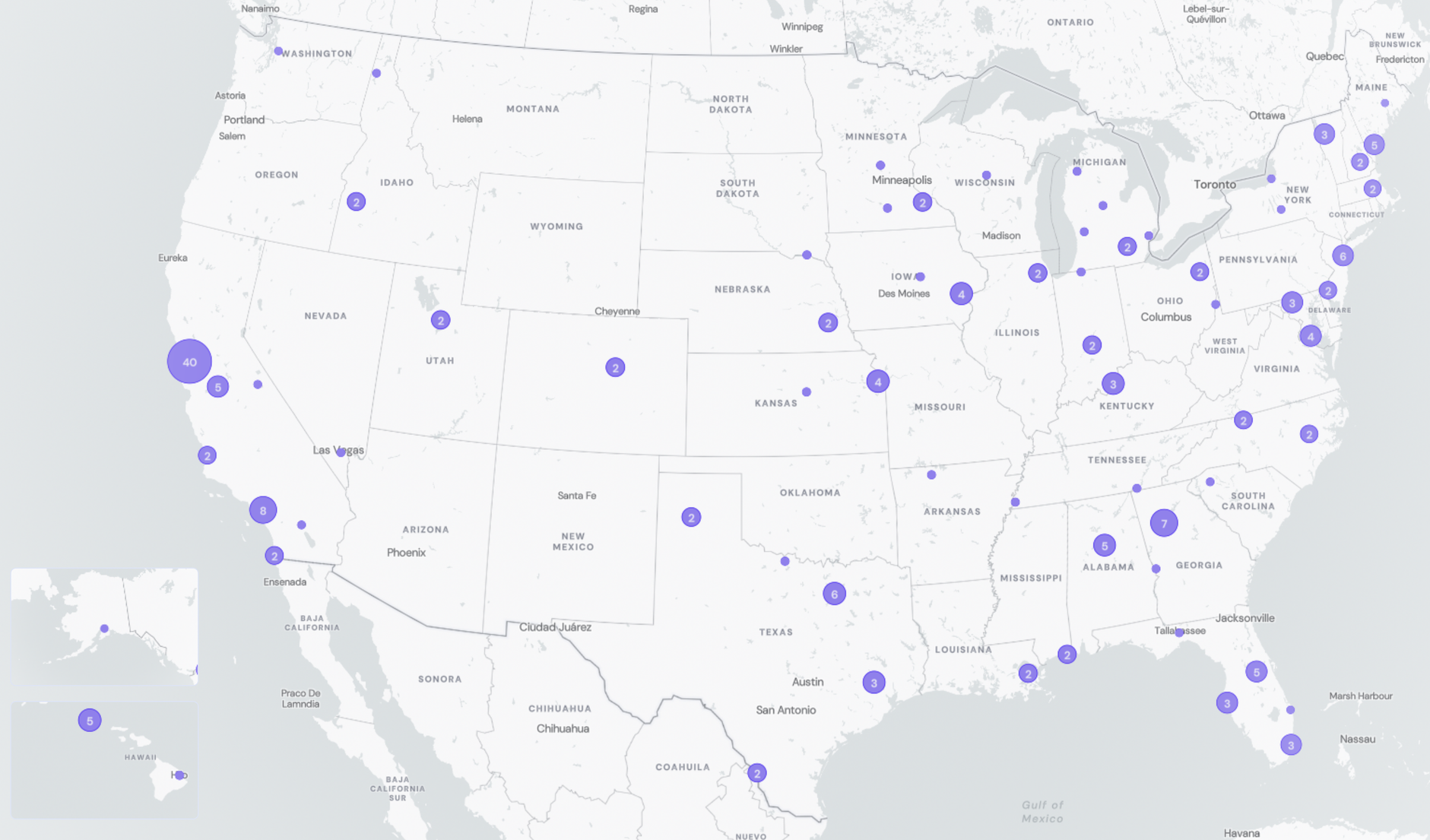
Infectious Disease Target Review
Currently monitoring a suite of Respiratory, Gastrointestinal and Outbreak Pathogens of Concern
The methods for our assays are in the public domain and links for these are provided at the end of the newsletter.

Program Publications
New WastewaterSCAN Published Body of Work document:
- We are excited to share a new document that provides an overview of the program’s peer-reviewed scientific literature, organized by topics and themes. Click here to access the WastewaterSCAN published body of work.
New Peer-Reviewed Scientific Publications:
- Spatial and temporal variation in respiratory syncytial virus (RSV) subtype RNA in wastewater and relation to clinical specimens
- Detection of Hemagglutinin H5 Influenza A Virus Sequence in Municipal Wastewater Solids at Wastewater Treatment Plants with Increases in Influenza A in Spring, 2024
- Solid–liquid partitioning of dengue, West Nile, Zika, hepatitis A, influenza A, and SARS-CoV-2 viruses in wastewater from across the USA
- Persistence of Human Respiratory Viral RNA in Wastewater Settled Solids
COVID-19
SARS-CoV-2 concentration in wastewater and sequencing for variants
SARS-CoV-2 N gene RNA median concentration across all sites in June 2024 was 85,481 copies/gram. For reference, the median concentration in June 2023 was 34,739 copies/gram. Below is the population weighted average SARS-CoV-2 N gene concentrations (normalized by PMMoV) from all participating WWSCAN sites across the country over the last 365 days.
Nationally, SARS-CoV-2 is in the "High" category with aggregated measurements showing medium concentrations and an upward over the past 21 days.

Below are the population-weighted average SARS-CoV-2 N gene concentrations (normalized by PMMoV) from sites in the Midwest US (top left panel), Northeast US (top right panel), Southern US (bottom left panel) and Western US (bottom right panel) over the last 365 days. Raw data have been omitted from the plots for clarity of presentation but are still available in the chart settings on dashboard.
The Midwest and Western regions are in the "High" Wastewater Category due to medium concentrations and an upward trend in the last 21 days. The Southern region is in the "High" Wastewater Category due to high concentrations and an upward trend in the last 21 days. The Northeast is in the "Medium" Wastewater Category due to medium concentrations and a downward trend in the last 21 days.
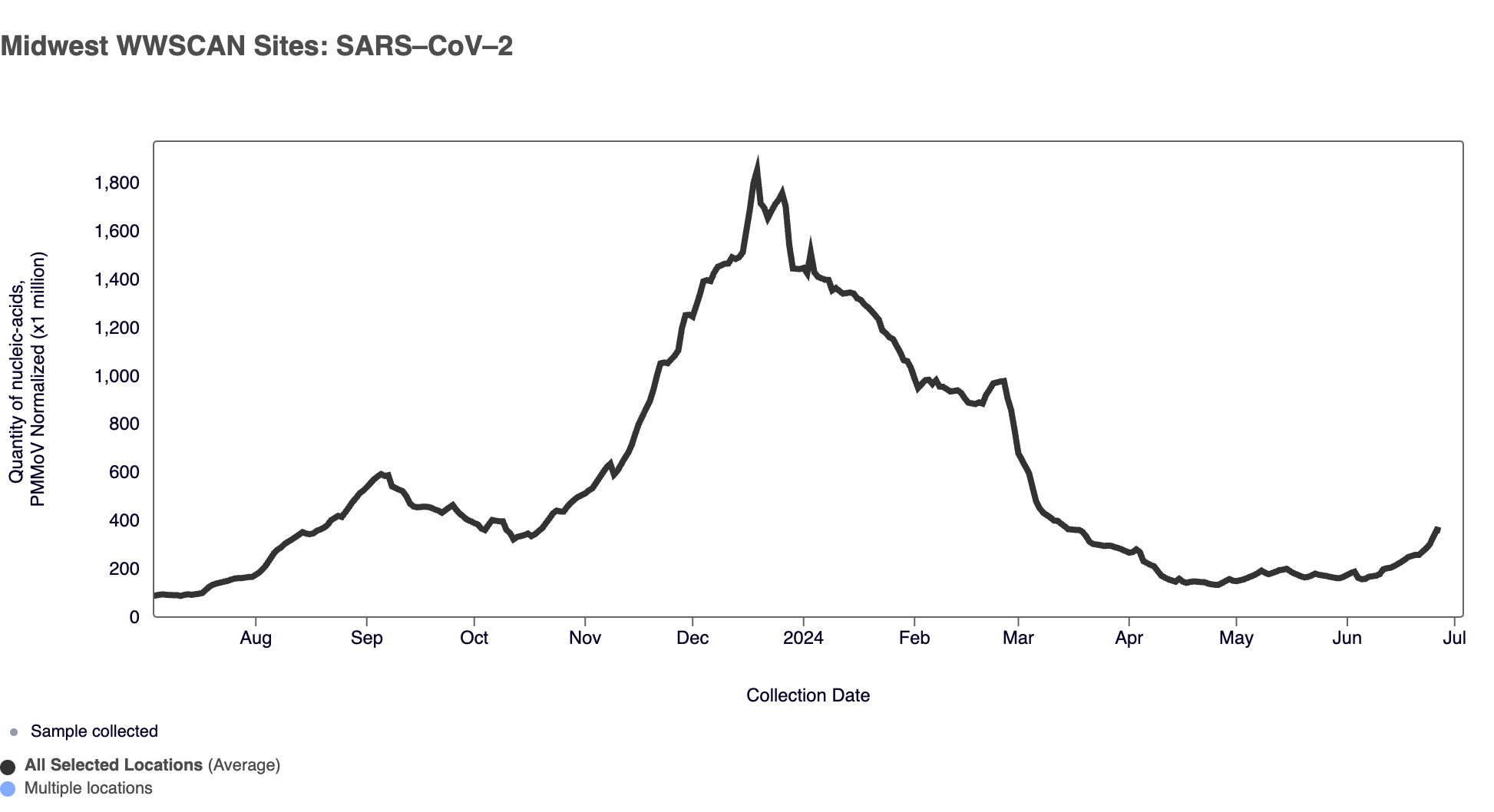
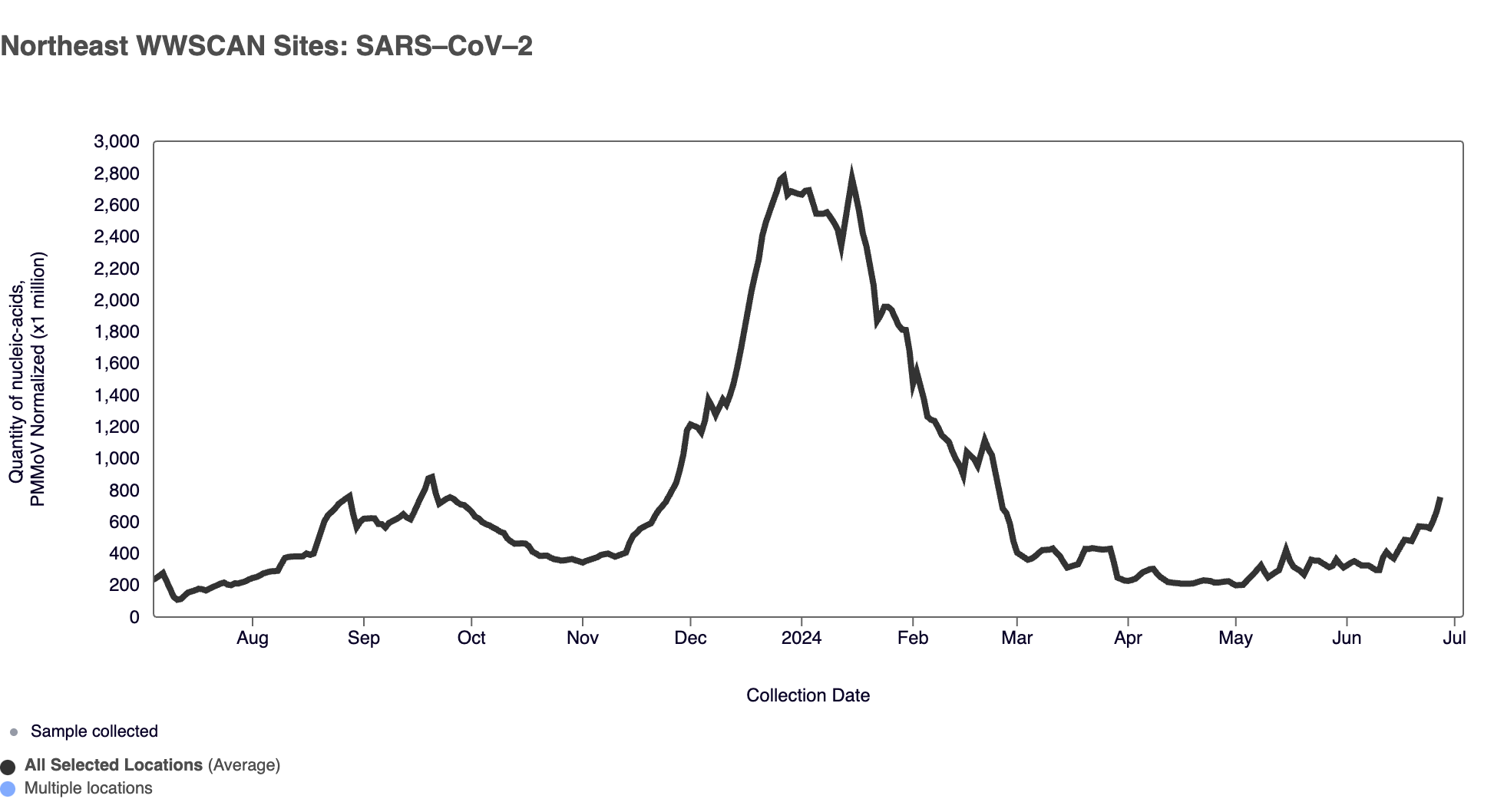

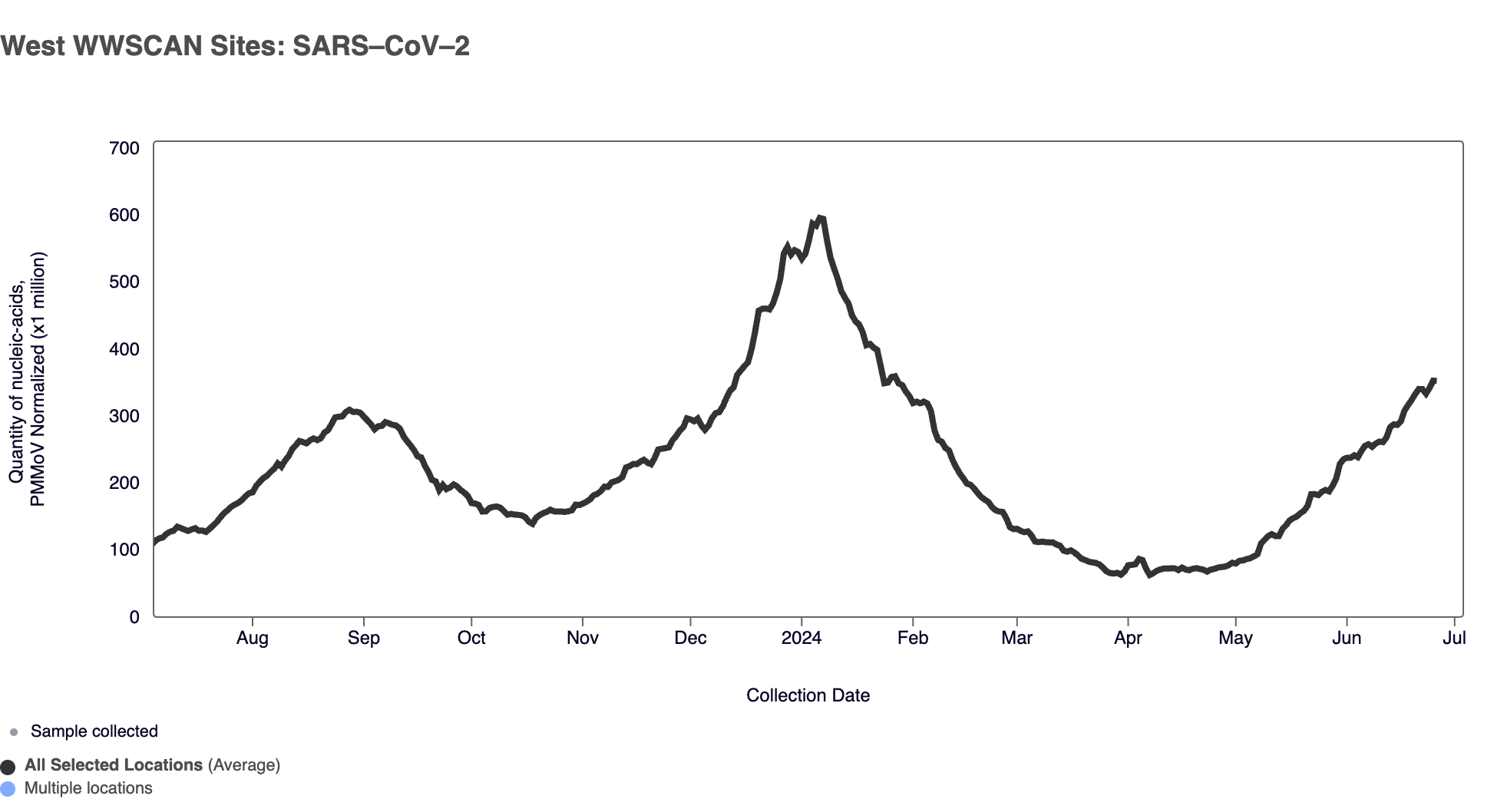
Midwest states: IA, IL, IN, KS, MI, MN, NE, OH, SD, WI. Northeast states: CT, MA, ME, NH, NJ, NY, PA, VT. Southern states: AL, AR, DE, FL, GA, KY, LA, MD, MS, NC, TN, TX, VA, WV and Washington DC. Western States: AK, CA, CO, HI, ID, NV, UT, WA.
Below are the current SARS-CoV-2 wastewater categories for all WWSCAN sites (recall the category is determined by both the trend and the level):
- 39 are in the LOW Wastewater Category
- 55 are in the MEDIUM Wastewater Category
- 77 are in the HIGH Wastewater Category
- 20 do not have enough data to calculate (Contra Costa County, CA; Mill Valley, CA; Newark, CA; Pacifica, CA; Petaluma, CA; San Rafael, CA; South San Diego, CA; Union City, CA; West Railroad, San Rafael, CA; Winters, CA; Blue Plains, Washington, DC; Key Biscayne, FL; South Miami, FL; Columbus, GA; Hilo, HI; York, ME; Gautier, MS; Memphis, TN; Hollywood Road, Amarillo, TX; River Road, Amarillo, TX)
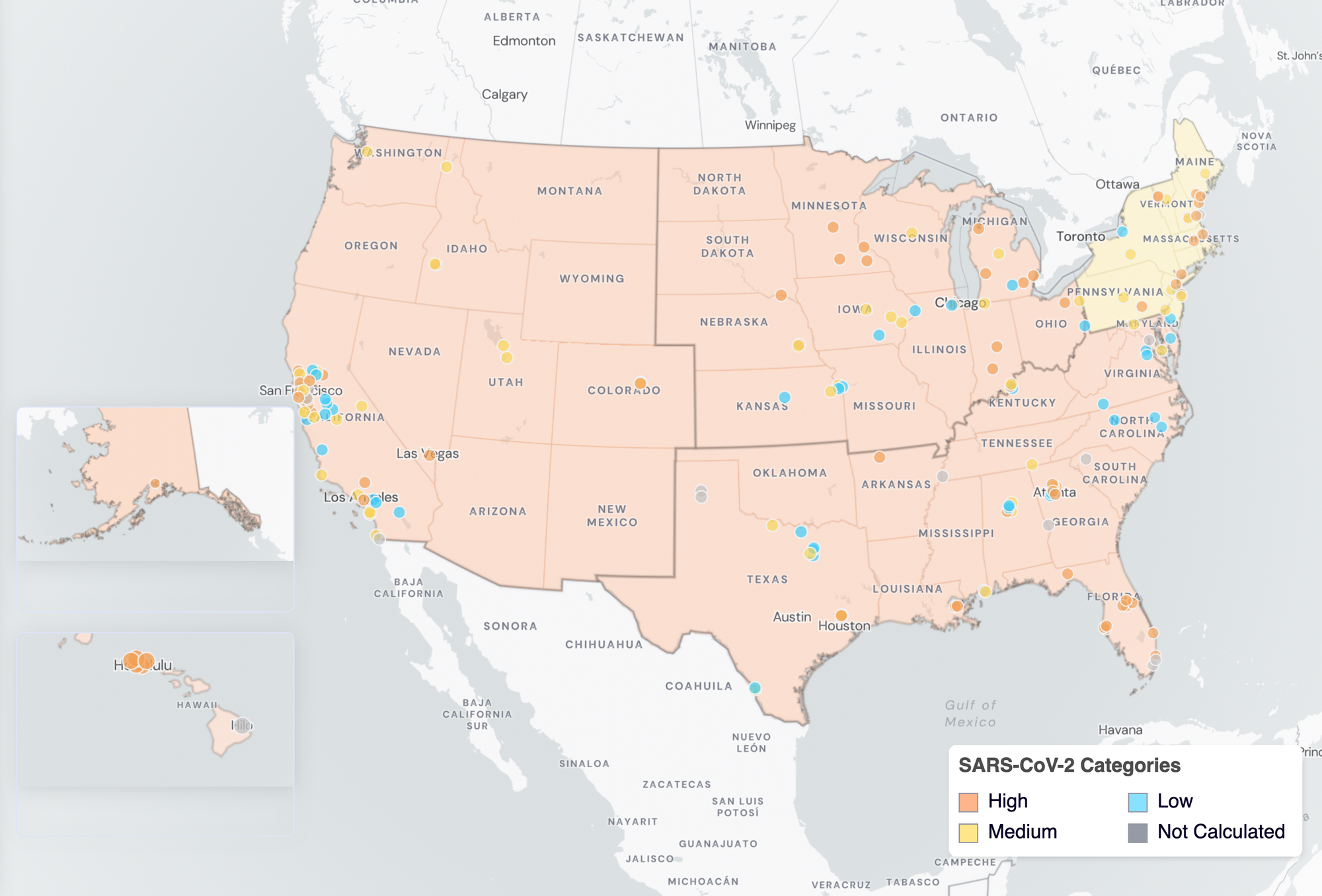
SARS-COV-2 Wastewater Categories. This map includes sample collection data through June 30, 2024. Each dot represents a single site and the four US Census regions are outlined in gray. Midwest Region includes: IA, IL, IN, KS, MI, MN, NE, OH, SD, WI. Northeast Region includes: CT, MA, ME, NH, NJ, NY, PA, VT. Southern Region includes: AL, AR, DE, FL, GA, KY, LA, MD, MS, NC, TN, TX, VA, WV and Washington DC. Western Region includes: AK, CA, CO, HI, ID, NV, UT, WA.
Sequencing of SARS-CoV-2 from wastewater is available for a select number of individual sites. The sequencing protocol is available on protocol.io. The plots below show the relative proportions of different variants inferred from sequencing the entire genome of SARS-CoV-2. Results are based on sequencing of 2 samples per week, combined to provide a weekly value.
Sequencing data is also available in aggregate across all sites in WWSCAN with sequencing data. That plot is shown below and also suggests that KP.2 (shown in slate blue) is the most abundant variant across all sites (23.6%) followed by JN.1.16 (shown in dark pink) (17.9%) and KP.1 (shown in lime green) (16.9%).

Data from the week of June 22, 2024 illustrates that KP.2 (slate blue) made up the largest proportion of the lineages detected at detected at Glen Ellyn, IL (46.9%) and Chester, PA (29.6%). Whereas KP.3 (light blue) made up the largest proportion of the lineages detected at detected at Sand Island, HI (46%) and Bessemer, AL (44.8%).
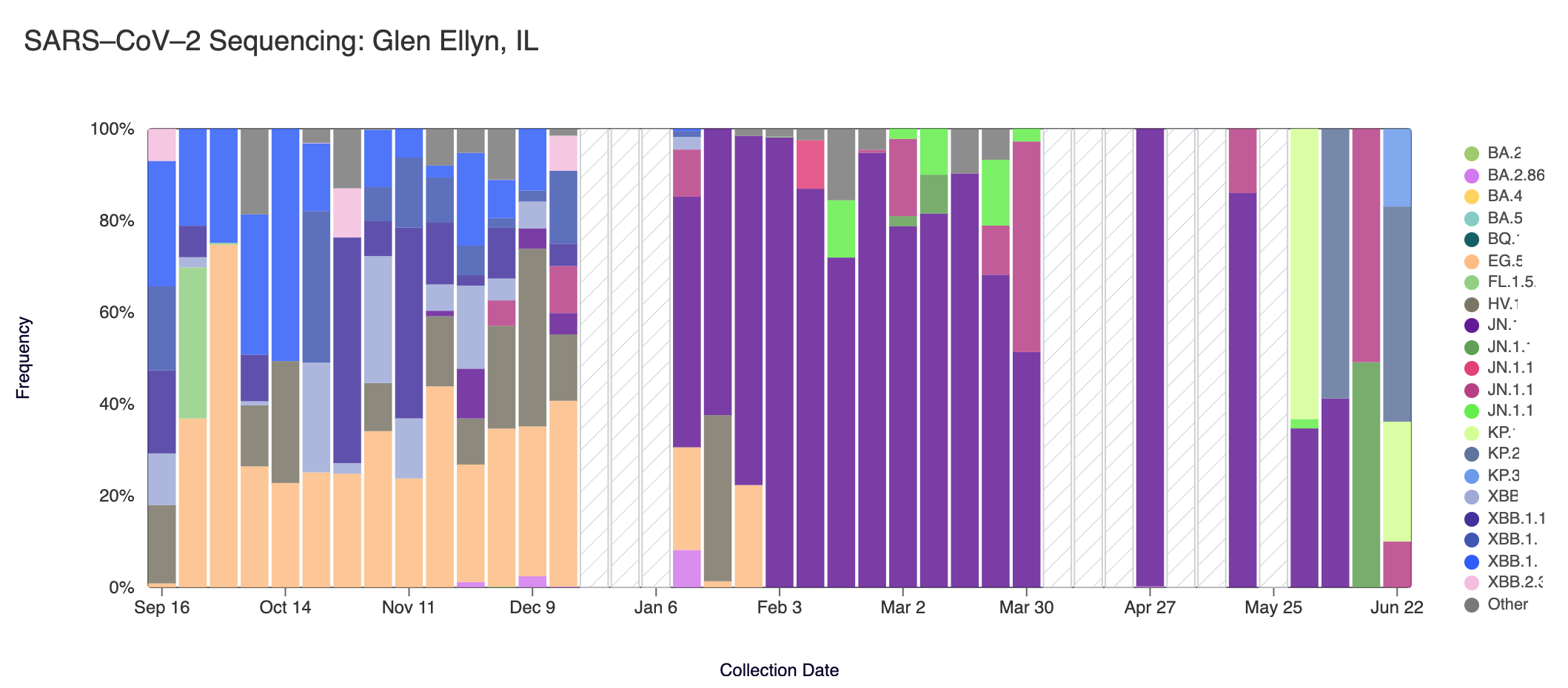
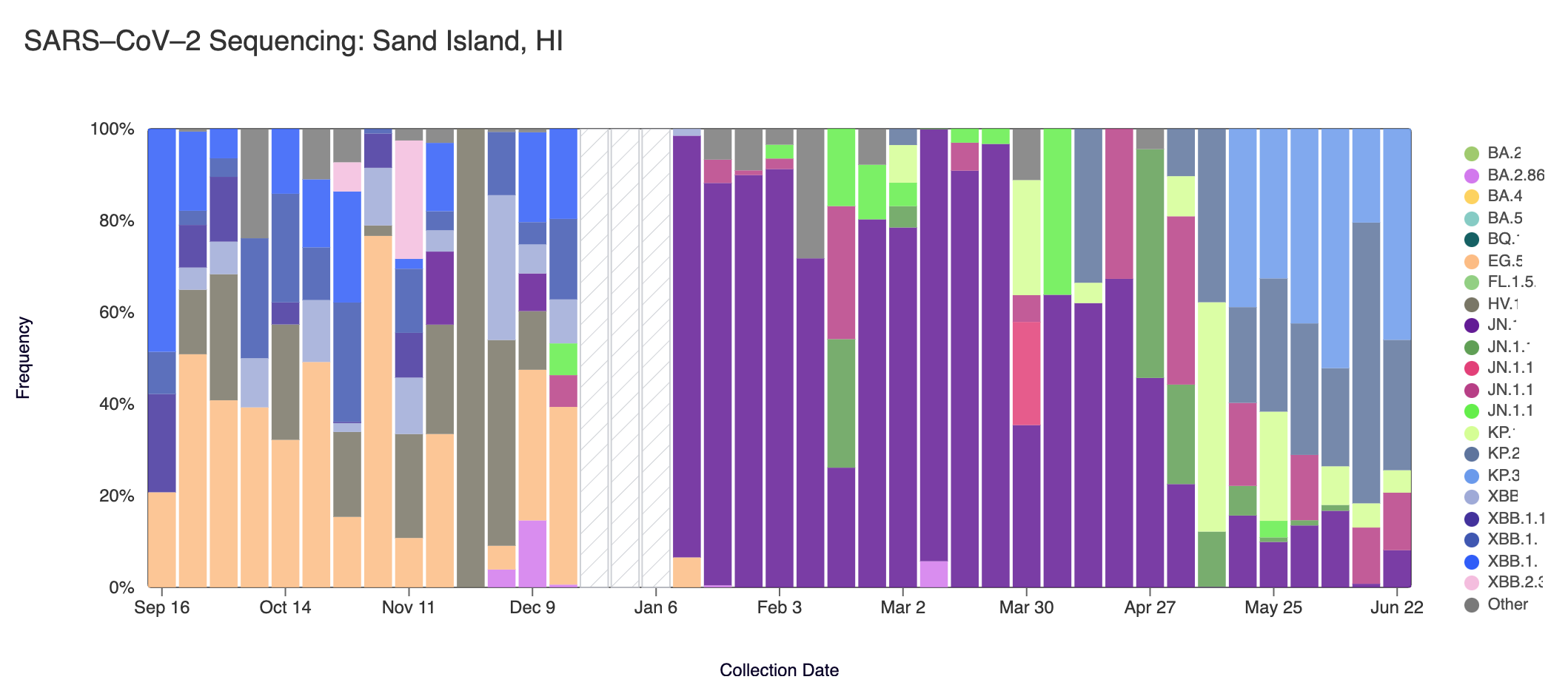
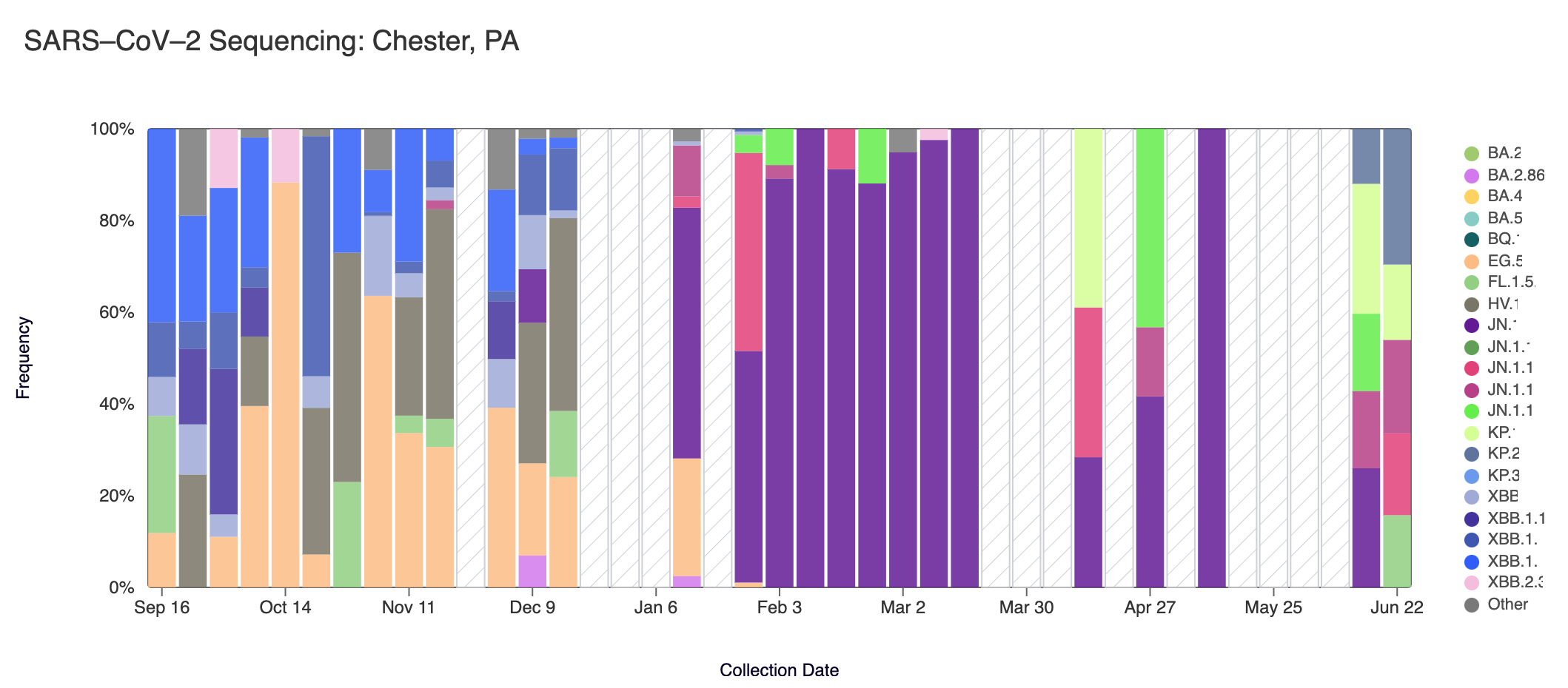

Plots show 1 site from the Midwest US (top left panel), West US (top right panel), Northeast US (bottom left panel) and South US (bottom right panel)
Other Respiratory Pathogens
Influenza A & B, Respiratory Syncytial Virus, Human metapneumovirus, Human Parainfluenza & EV-D68
Influenza A (IAV) RNA median concentration across all sites June 2024 was below the limit of detection. For reference, the median concentration in May 2024 was 3,893 copies/gram. Below is the population weighted average IAV concentrations (normalized by PMMoV) from all participating WWSCAN sites across the country over the last 365 days.
Nationally, Influenza A is in the "Low" Wastewater Category with <50% of sites showing onset of IBV in wastewater.

Below are the current Influenza A wastewater categories for all WWSCAN sites (recall the category is determined by both the trend and the level when in seasonal onset):
- 143 are in the LOW Wastewater Category
- 21 are in the MEDIUM Wastewater Category
- 7 are in the HIGH Wastewater Category
- 20 do not have enough data to calculate (Contra Costa County, CA; Mill Valley, CA; Newark, CA; Pacifica, CA; Petaluma, CA; San Rafael, CA; South San Diego, CA; Union City, CA; West Railroad, San Rafael, CA; Winters, CA; Blue Plains, Washington, DC; Key Biscayne, FL; South Miami, FL; Columbus, GA; Hilo, HI; York, ME; Gautier, MS; Memphis, TN; Hollywood Road, Amarillo, TX; River Road, Amarillo, TX)
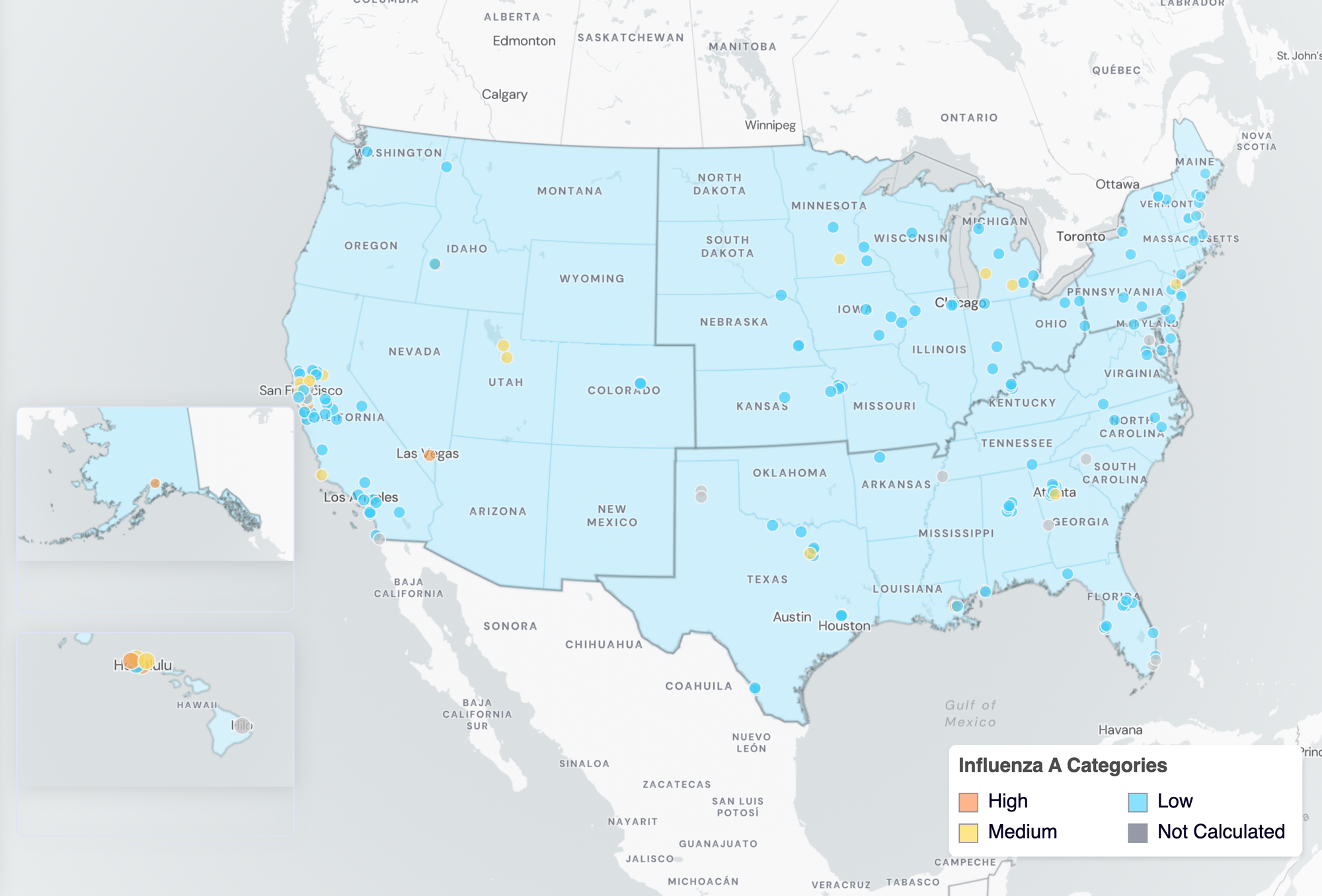
IAV Wastewater Categories. This map includes sample collection data through June 30, 2024. Each dot represents a single site and the four US Census regions are outlined in gray. Midwest Region includes: IA, IL, IN, KS, MI, MN, NE, OH, SD, WI. Northeast Region includes: CT, MA, ME, NH, NJ, NY, PA, VT. Southern Region includes: AL, AR, DE, FL, GA, KY, LA, MD, MS, NC, TN, TX, VA, WV and Washington DC. Western Region includes: AK, CA, CO, HI, ID, NV, UT, WA.
H5 Marker in Influenza A (IAV) Since we started monitoring for the H5 marker in influenza A, 20 sites have seen positive detections.
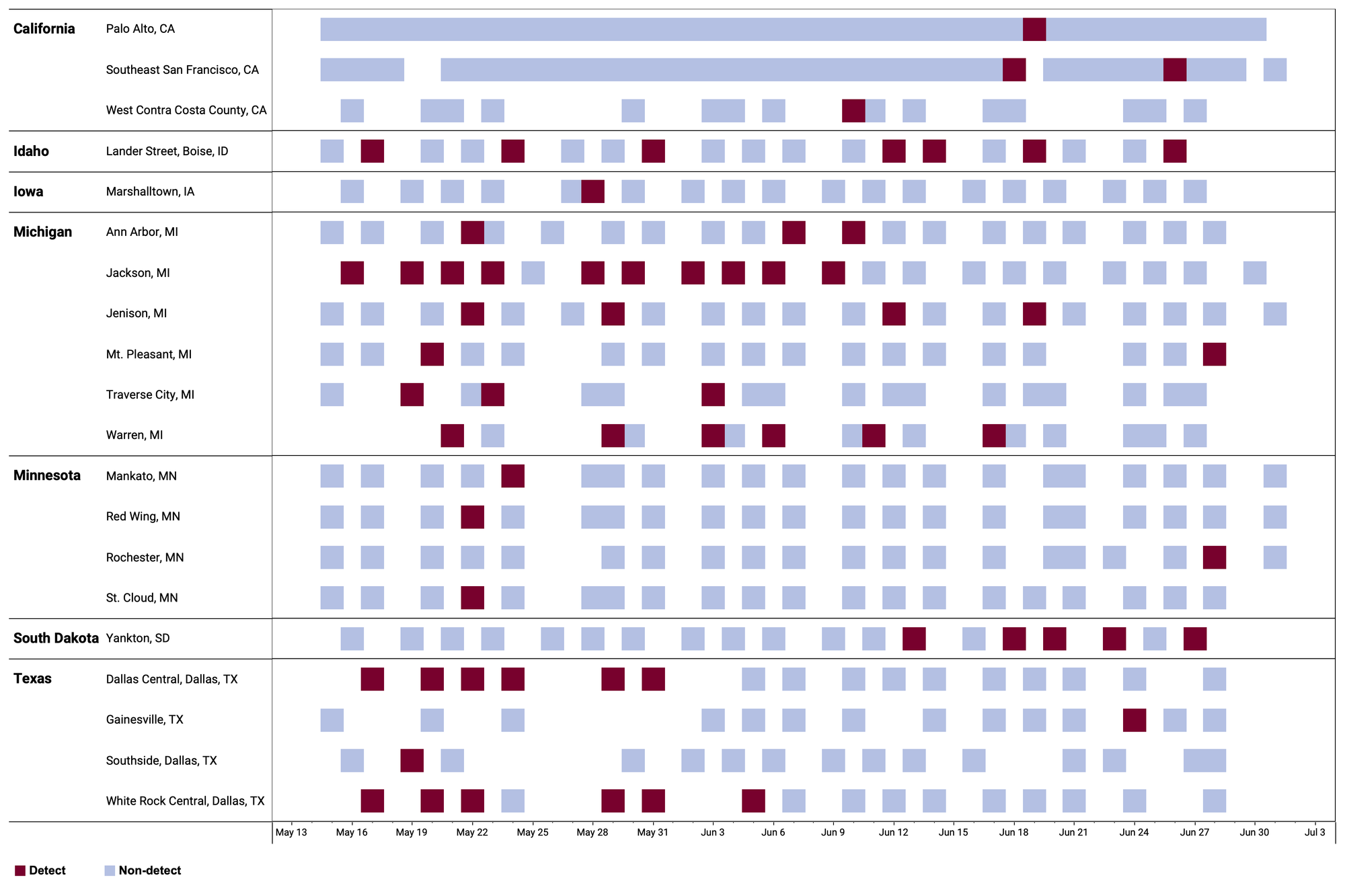
Influenza B (IBV) RNA was detected in ~18.6% of samples in June 2024. IBV RNA median concentration across all sites in June 2024 was below the limit of detection. Below is the population-weighted average IBV RNA concentrations (normalized by PMMoV) from all participating WWSCAN sites across the country over the last 365 days.
Nationally, Influenza B is in the "Low" Wastewater Category with <50% of sites showing onset of IBV in wastewater.

Below are the current Influenza B wastewater categories for all WWSCAN sites, with ~1.5% of sites showing wastewater onset for IBV (recall the category is determined by both the trend and the level when in seasonal onset):
- 168 are in the LOW Wastewater Category
- 3 are in the MEDIUM Wastewater Category
- 0 are in the HIGH Wastewater Category
- 20 do not have enough data to calculate (Contra Costa County, CA; Mill Valley, CA; Newark, CA; Pacifica, CA; Petaluma, CA; San Rafael, CA; South San Diego, CA; Union City, CA; West Railroad, San Rafael, CA; Winters, CA; Blue Plains, Washington, DC; Key Biscayne, FL; South Miami, FL; Columbus, GA; Hilo, HI; York, ME; Gautier, MS; Memphis, TN; Hollywood Road, Amarillo, TX; River Road, Amarillo, TX)
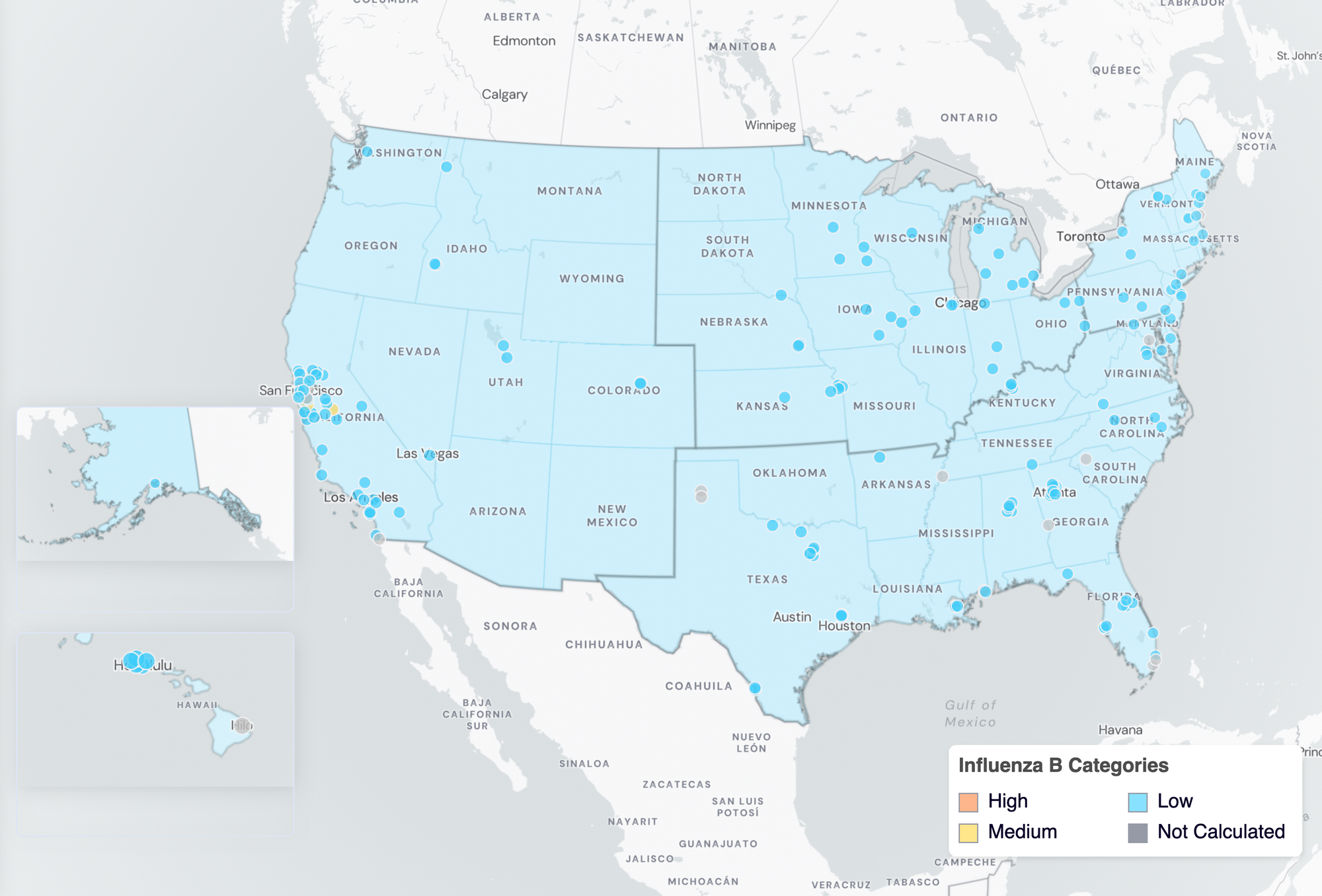
IBV Wastewater Categories. This map includes sample collection data through June 30, 2024. Each dot represents a single site and the four US Census regions are outlined in gray. Midwest Region includes: IA, IL, IN, KS, MI, MN, NE, OH, SD, WI. Northeast Region includes: CT, MA, ME, NH, NJ, NY, PA, VT. Southern Region includes: AL, AR, DE, FL, GA, KY, LA, MD, MS, NC, TN, TX, VA, WV and Washington DC. Western Region includes: AK, CA, CO, HI, ID, NV, UT, WA.
Respiratory syncytial virus (RSV) RSV RNA median concentration across all sites in June 2024 was below the limit of detection. Below are the RSV RNA concentrations (normalized by PMMoV) from all participating WWSCAN sites across the country over the last 365 days shown as the population-weighted average.
Nationally, RSV is in the "Low" Wastewater Category, with <50% of sites showing onset of RSV in wastewater.

Below are the current RSV wastewater categories for all WWSCAN sites (recall the category is determined by both the trend and the level when in seasonal onset):
- 171 are in the LOW Wastewater Category
- 0 are in the MEDIUM Wastewater Category
- 0 are in the HIGH Wastewater Category
- 20 do not have enough data to calculate (Contra Costa County, CA; Mill Valley, CA; Newark, CA; Pacifica, CA; Petaluma, CA; San Rafael, CA; South San Diego, CA; Union City, CA; West Railroad, San Rafael, CA; Winters, CA; Blue Plains, Washington, DC; Key Biscayne, FL; South Miami, FL; Columbus, GA; Hilo, HI; York, ME; Gautier, MS; Memphis, TN; Hollywood Road, Amarillo, TX; River Road, Amarillo, TX)
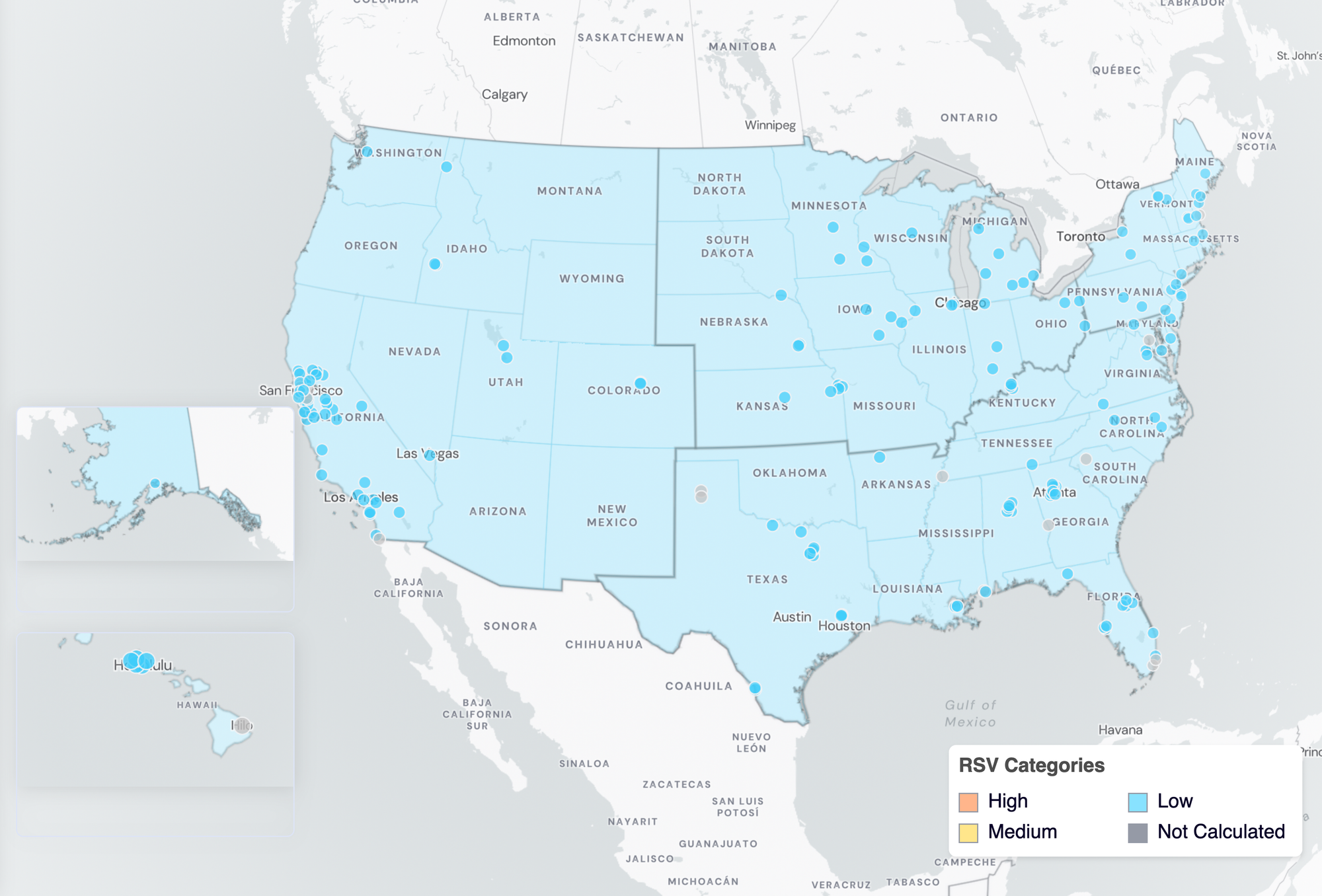
RSV Wastewater Categories. This map includes sample collection data through June 30, 2024. Each dot represents a single site and the four US Census regions are outlined in gray. Midwest Region includes: IA, IL, IN, KS, MI, MN, NE, OH, SD, WI. Northeast Region includes: CT, MA, ME, NH, NJ, NY, PA, VT. Southern Region includes: AL, AR, DE, FL, GA, KY, LA, MD, MS, NC, TN, TX, VA, WV and Washington DC. Western Region includes: AK, CA, CO, HI, ID, NV, UT, WA.
HMPV (human metapneumovirus) RNA median concentrations across all sites in June 2024 was below the level of detection. HMPV RNA was detected in ~47% of samples in June 2024. Below is the population weighted average HMPV RNA concentrations (normalized by PMMoV) from all participating WWSCAN sites across the country over the last 365 days.
Nationally, HMPV is in the "LOW" Wastewater Category with <50% of sites showing onset of HMPV in wastewater.

Below are the population-weighted average HMPV RNA concentrations (normalized by PMMoV) from sites in the Midwest US (top left panel), Northeast US (top right panel), Southern US (bottom left panel) and Western US (bottom right panel) over the last 365 days.
The plots below show relatively low concentrations on HMPV RNA across all US regions.
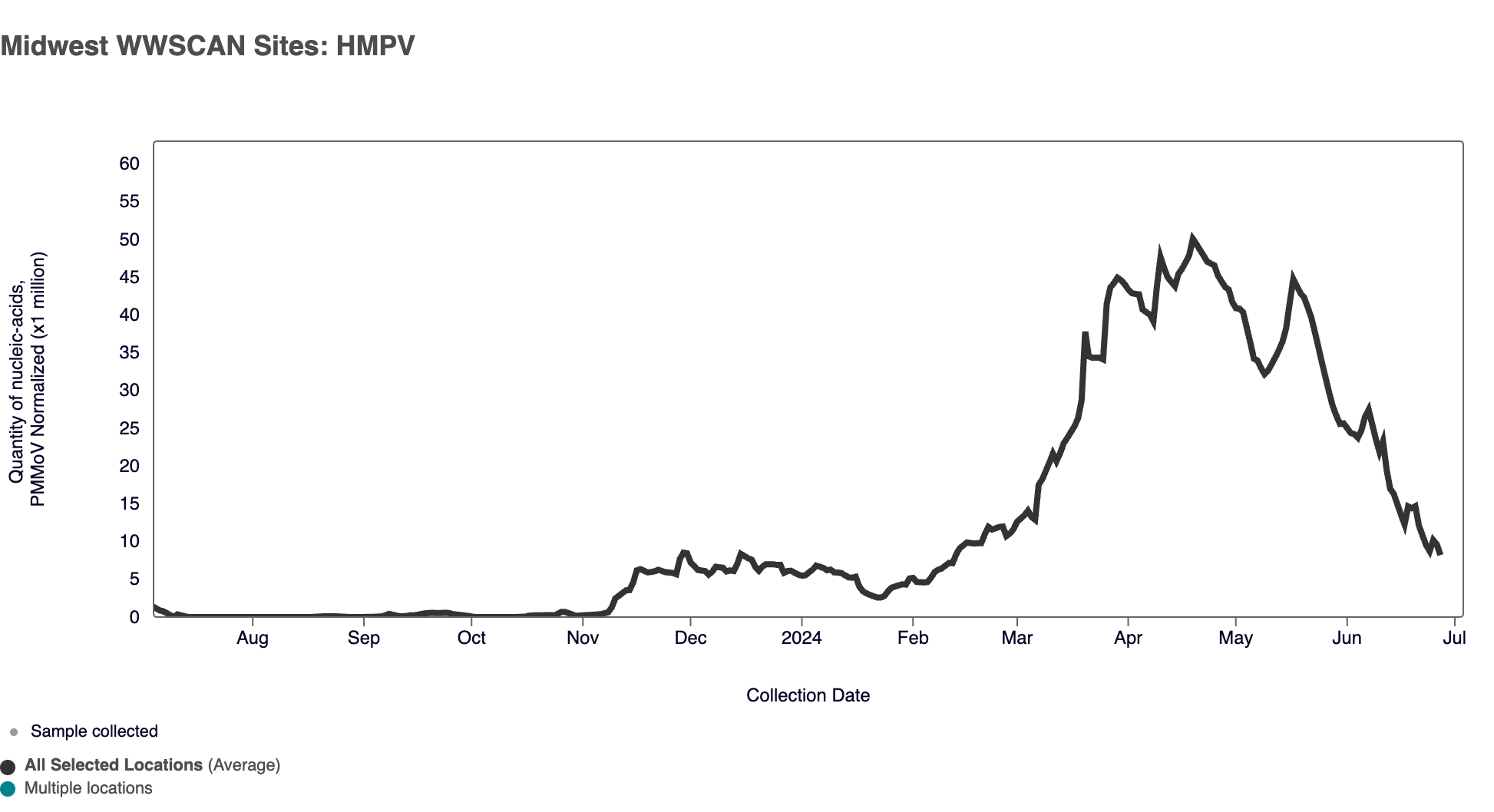
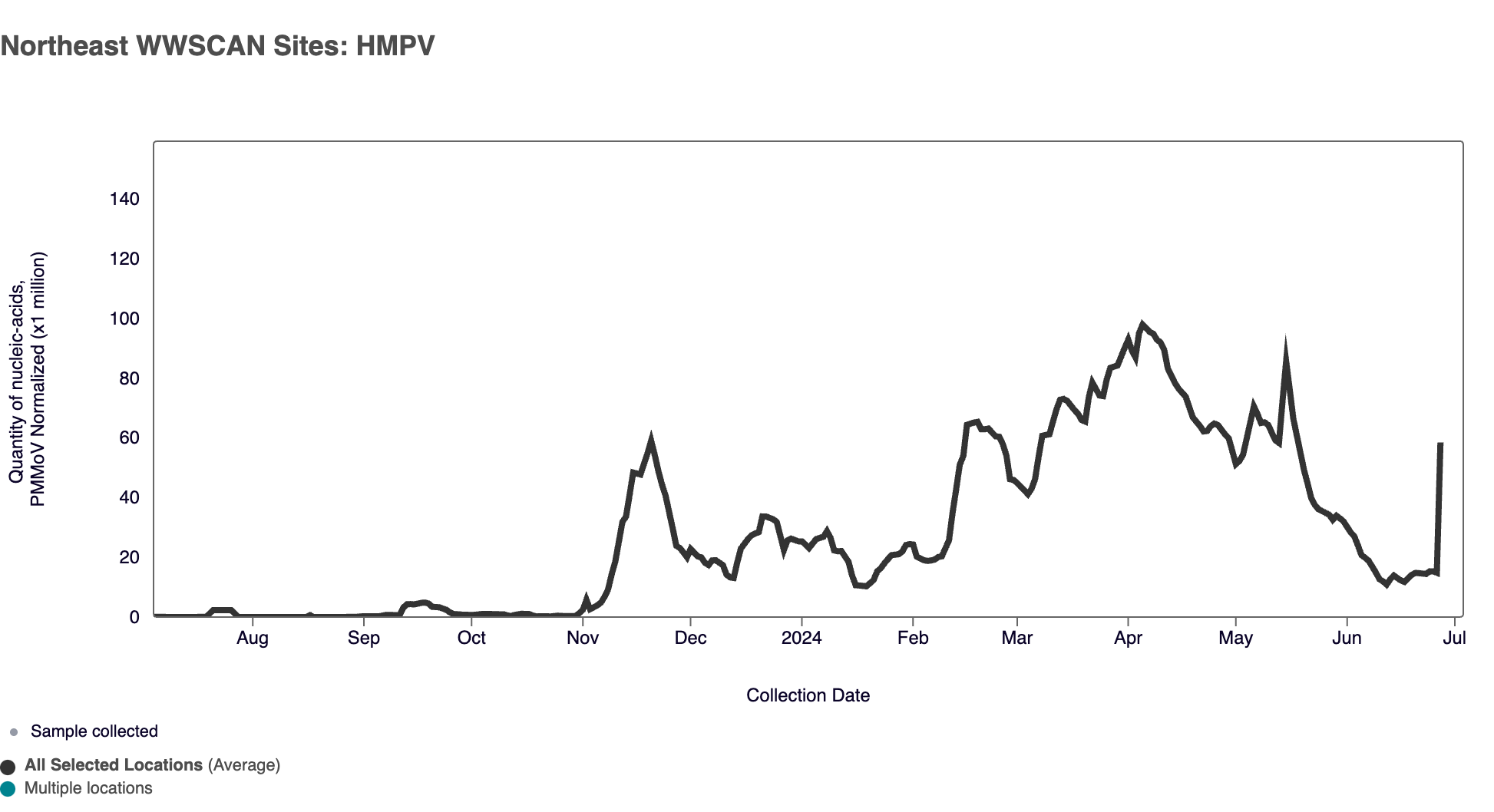


Midwest states: IA, IL, IN, KS, MI, MN, NE, OH, SD, WI. Northeast states: CT, MA, ME, NH, NJ, NY, PA, VT. Southern states: AL, AR, DE, FL, GA, KY, LA, MD, MS, NC, TN, TX, VA, WV and Washington DC. Western States: AK, CA, CO, HI, ID, NV, UT, WA.
Below are the current HMPV wastewater categories for all WWSCAN sites (recall the category is determined by both the trend and the level):
- 135 are in the LOW Wastewater Category
- 17 are in the MEDIUM Wastewater Category
- 19 are in the HIGH Wastewater Category
- 20 do not have enough data to calculate (Contra Costa County, CA; Mill Valley, CA; Newark, CA; Pacifica, CA; Petaluma, CA; San Rafael, CA; South San Diego, CA; Union City, CA; West Railroad, San Rafael, CA; Winters, CA; Blue Plains, Washington, DC; Key Biscayne, FL; South Miami, FL; Columbus, GA; Hilo, HI; York, ME; Gautier, MS; Memphis, TN; Hollywood Road, Amarillo, TX; River Road, Amarillo, TX)

HMPV Wastewater Categories. This map includes sample collection data through June 30, 2024. Each dot represents a single site and the four US Census regions are outlined in gray. Midwest Region includes: IA, IL, IN, KS, MI, MN, NE, OH, SD, WI. Northeast Region includes: CT, MA, ME, NH, NJ, NY, PA, VT. Southern Region includes: AL, AR, DE, FL, GA, KY, LA, MD, MS, NC, TN, TX, VA, WV and Washington DC. Western Region includes: AK, CA, CO, HI, ID, NV, UT, WA.
Enterovirus D68 (EV-D68) RNA was detected in ~26% of samples collected in June 2024 across WWSCAN sites and the median concentration across all sites was below the level of detection.
The chart below plants in Texas as rows, and the days as columns (labeled at the bottom axis). White indicates no samples, blue is non-detect for EV-D68 RNA and red is detect for EV-D68 RNA.

Below are the current EV-D68 wastewater categories for all WWSCAN sites (recall the category is determined by the frequency of detection):
- 127 are in the LOW Wastewater Category
- 44 are in the MEDIUM Wastewater Category
- 0 are in the HIGH Wastewater Category
- 20 do not have enough data to calculate (Contra Costa County, CA; Mill Valley, CA; Newark, CA; Pacifica, CA; Petaluma, CA; San Rafael, CA; South San Diego, CA; Union City, CA; West Railroad, San Rafael, CA; Winters, CA; Blue Plains, Washington, DC; Key Biscayne, FL; South Miami, FL; Columbus, GA; Hilo, HI; York, ME; Gautier, MS; Memphis, TN; Hollywood Road, Amarillo, TX; River Road, Amarillo, TX)
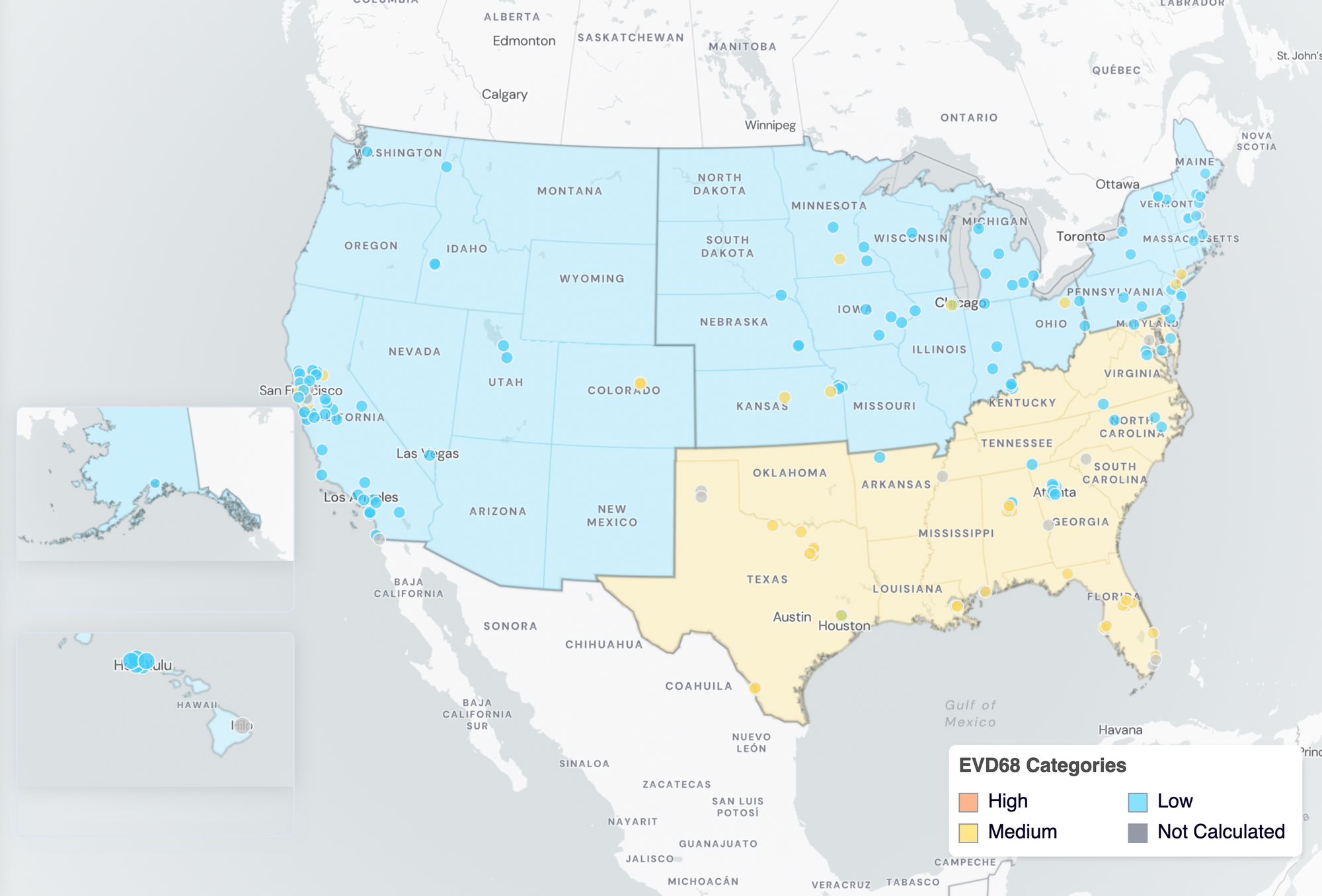
EV-D68 Wastewater Categories. This map includes sample collection data through June 30, 2024. Each dot represents a single site and the four US Census regions are outlined in gray. Midwest Region includes: IA, IL, IN, KS, MI, MN, NE, OH, SD, WI. Northeast Region includes: CT, MA, ME, NH, NJ, NY, PA, VT. Southern Region includes: AL, AR, DE, FL, GA, KY, LA, MD, MS, NC, TN, TX, VA, WV and Washington DC. Western Region includes: AK, CA, CO, HI, ID, NV, UT, WA.
Gastrointestinal Pathogens
Norovirus GII and Rotavirus
Norovirus GII (HuNoV GII) RNA was detected in all samples analyzed in June 2024. The median concentrations across all sites in June 2024 is 7,4276,186 copies/gram (for reference median concentration in May 2024 was 10,655,067 copies/gram). Below are the HuNoV GII RNA concentrations (normalized by PMMoV) from all participating WWSCAN sites across the country over the last 365 days. The population-weighted average is shown.
Nationally, Norovirus is in the "Medium" Wastewater Category with aggregated measurements showing medium concentrations and a downward trend over the past 21 days.

Below are the population-weighted average HuNoV GII RNA concentrations (normalized by PMMoV) from sites in the Midwest US (top left panel), Northeast US (top right panel), Southern US (bottom left panel) and Western US (bottom right panel).
All regions are in the "Medium" Wastewater Category. The aggregated measurements in the Northeast & West show no significant upward or downward trend over the last 21 days while there is a downward trend in the Midwest & South.
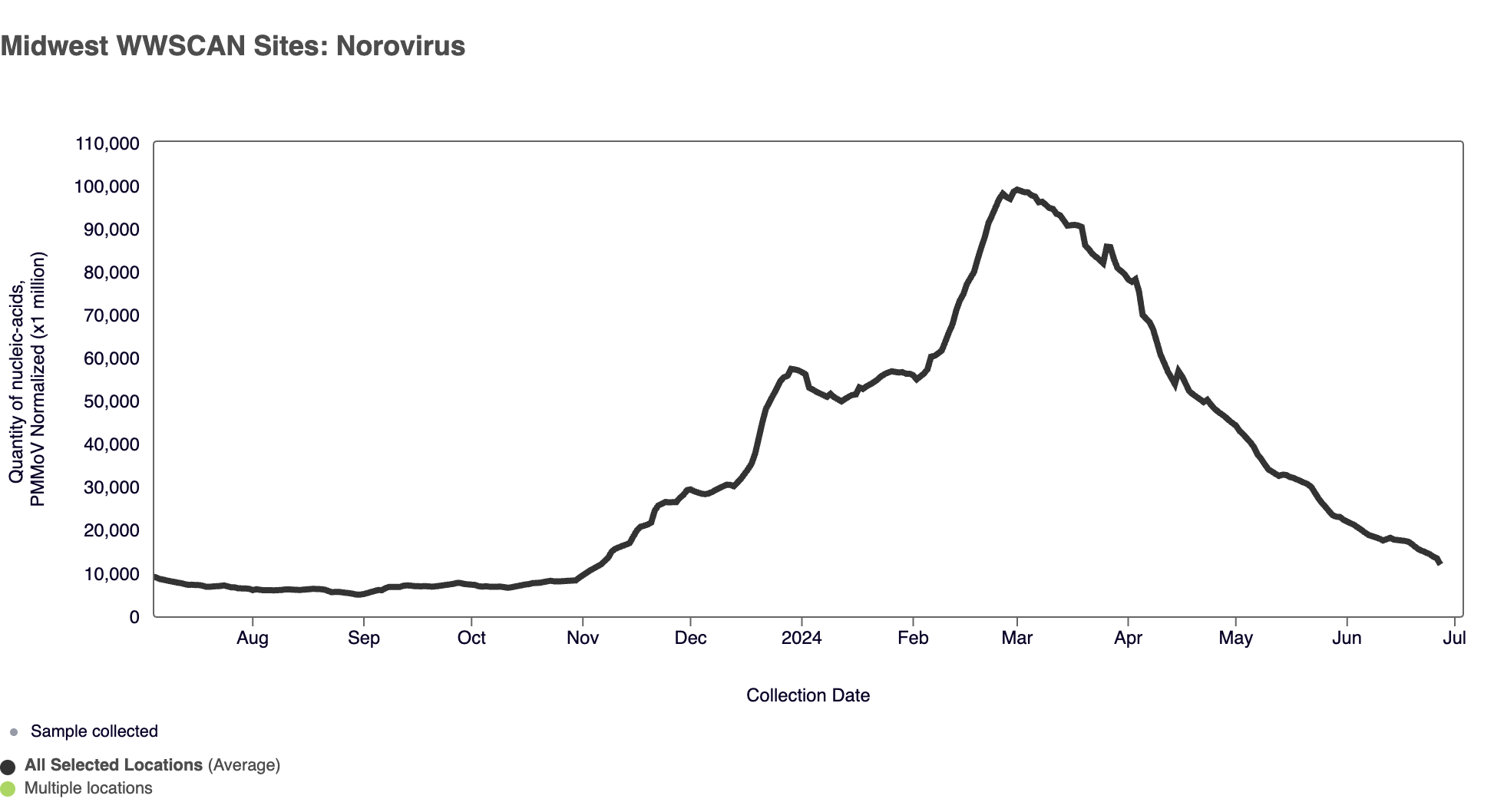
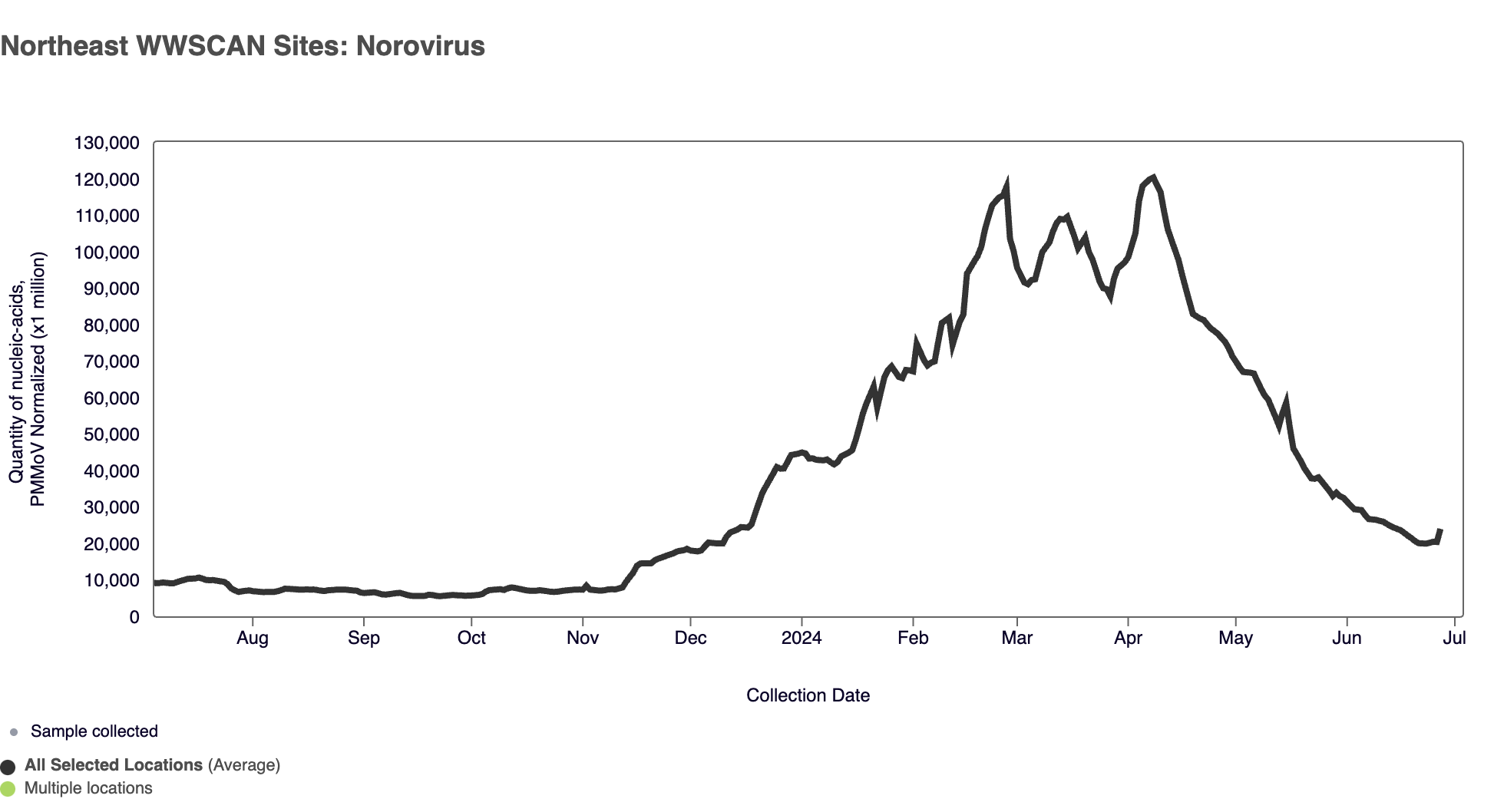
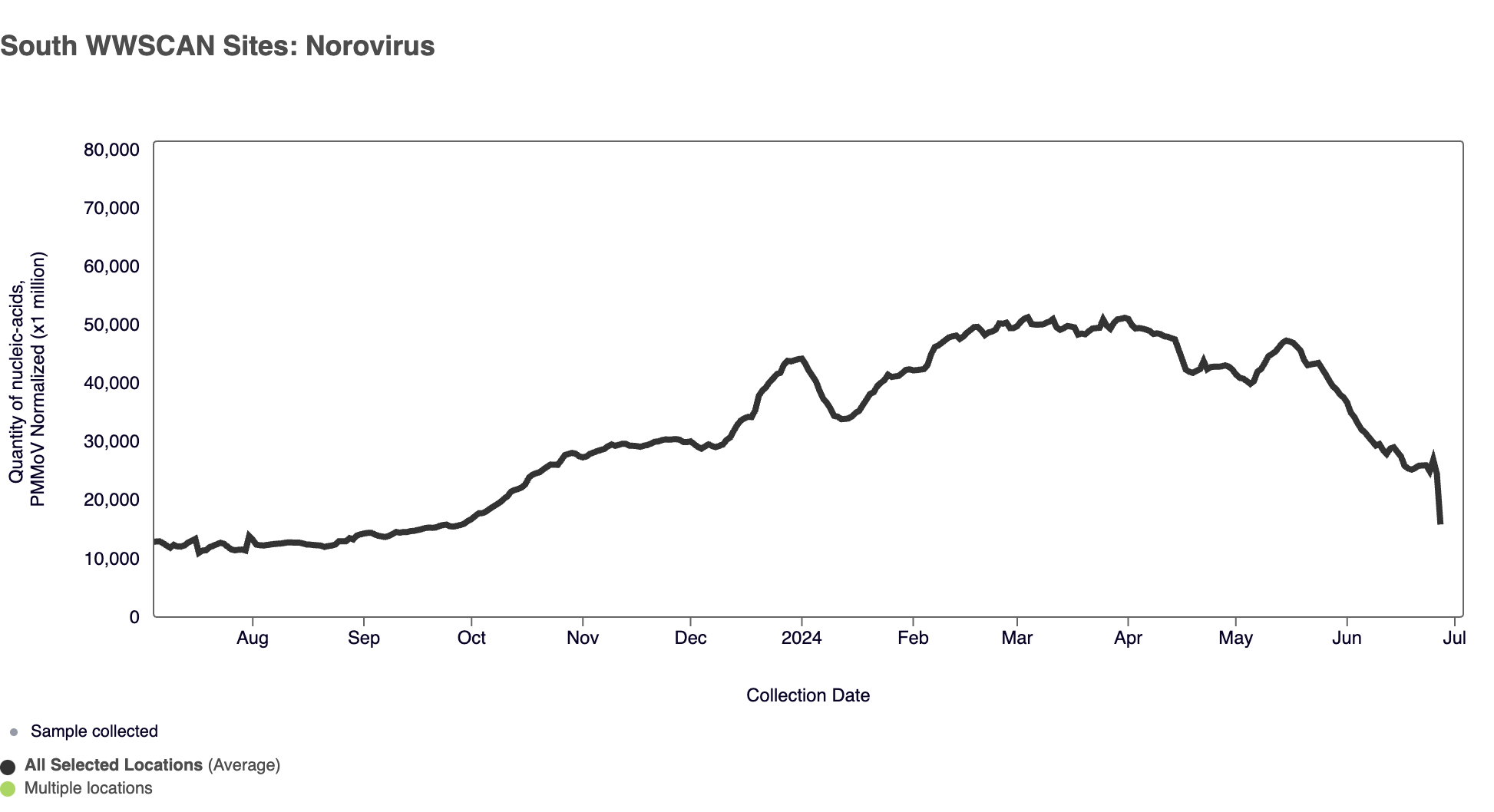
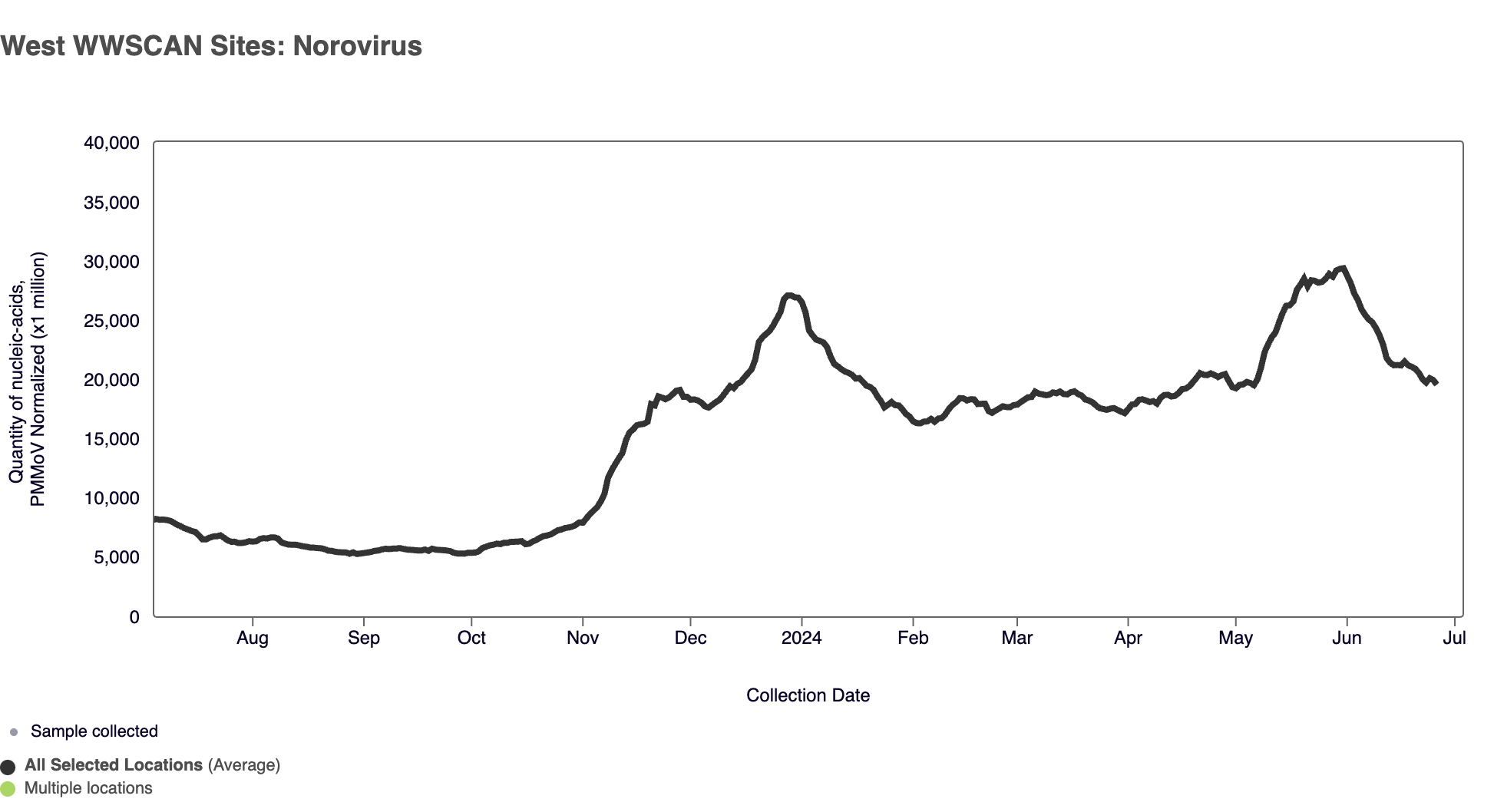
Midwest states: IA, IL, IN, KS, MI, MN, NE, OH, SD, WI. Northeast states: CT, MA, ME, NH, NJ, NY, PA, VT. Southern states: AL, AR, DE, FL, GA, KY, LA, MD, MS, NC, TN, TX, VA, WV and Washington DC. Western States: AK, CA, CO, HI, ID, NV, UT, WA.
Below are the current Norovirus wastewater categories for all WWSCAN sites (recall the category is determined by both the trend and the level):
- 45 are in the LOW Wastewater Category
- 76 are in the MEDIUM Wastewater Category
- 50 are in the HIGH Wastewater Category
- 20 do not have enough data to calculate (Contra Costa County, CA; Mill Valley, CA; Newark, CA; Pacifica, CA; Petaluma, CA; San Rafael, CA; South San Diego, CA; Union City, CA; West Railroad, San Rafael, CA; Winters, CA; Blue Plains, Washington, DC; Key Biscayne, FL; South Miami, FL; Columbus, GA; Hilo, HI; York, ME; Gautier, MS; Memphis, TN; Hollywood Road, Amarillo, TX; River Road, Amarillo, TX)
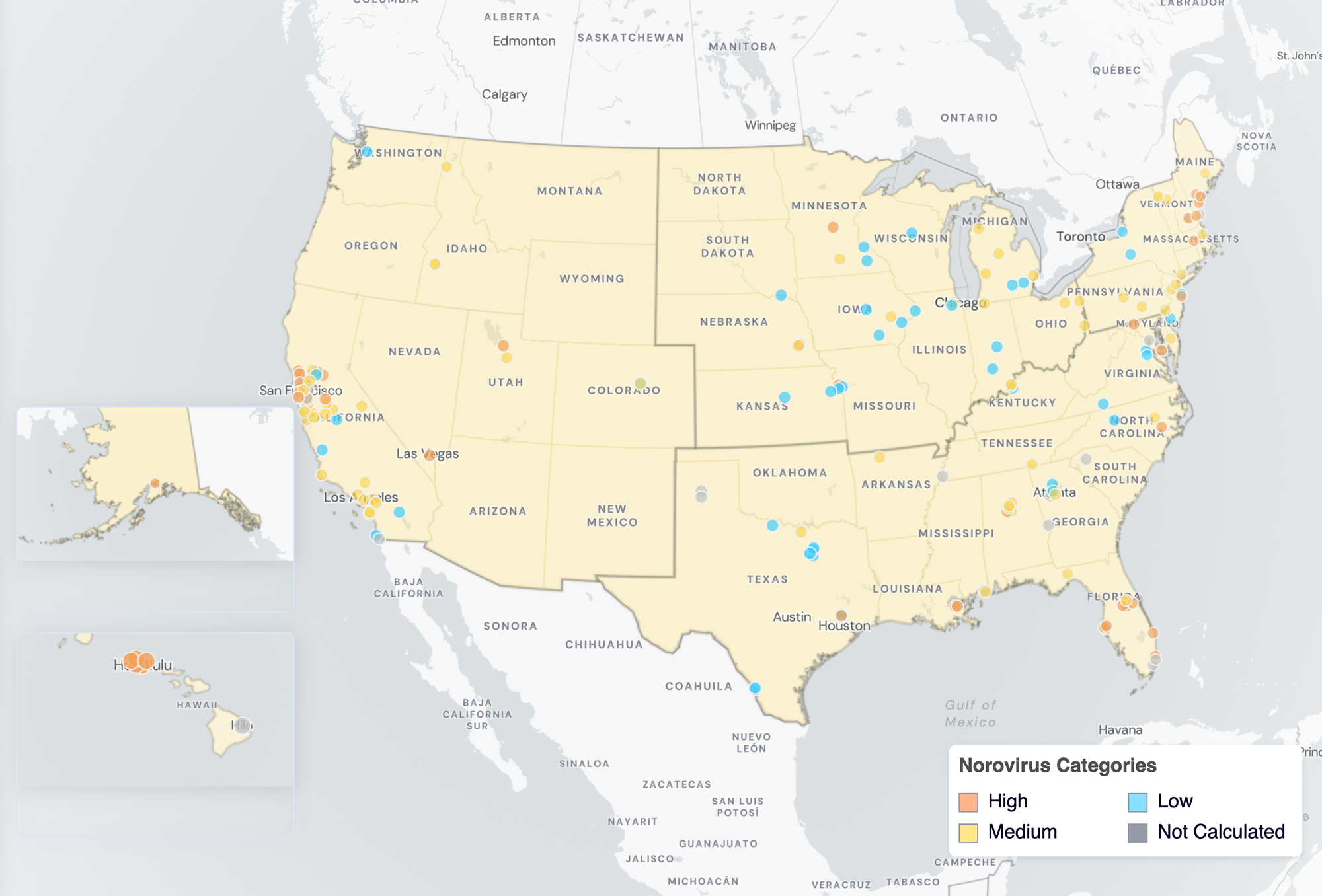
Norovirus Wastewater Categories. This map includes sample collection data through June 30, 2024. Each dot represents a single site and the four US Census regions are outlined in gray. Midwest states: IA, IL, IN, KS, MI, MN, NE, OH, SD, WI. Northeast states: CT, MA, ME, NH, NJ, NY, PA, VT. Southern states: AL, AR, DE, FL, GA, KY, LA, MD, MS, NC, TN, TX, VA, WV and Washington DC. Western States: AK, CA, CO, HI, ID, NV, UT, WA.
Rotavirus RNA median concentrations across all sites in June 2024 is 97,917 copies/gram. For reference, the median concentration in May 2024 was 237,498 copies/gram. Below are the Rotavirus RNA concentrations (normalized by PMMoV) from all participating WWSCAN sites across the country. The population-weighted average is shown.
Rotavirus is in the "Medium" Wastewater Category nationally with aggregated measurements showing medium concentrations with a downward trend in the last 21 days.

Below are the population-weighted average Rotavirus RNA concentrations (normalized by PMMoV) from sites in the Midwest US (top left panel), Northeast US (top right panel), Southern US (bottom left panel) and Western US (bottom right panel).
The Midwest, South and West regions are in the "Medium" Wastewater Category for Rotavirus with medium concentrations and a downward trend over the last 21 days. The Northeast is in the 'High" Wastewater Category for high concentrations but no significant trend upward or downward.
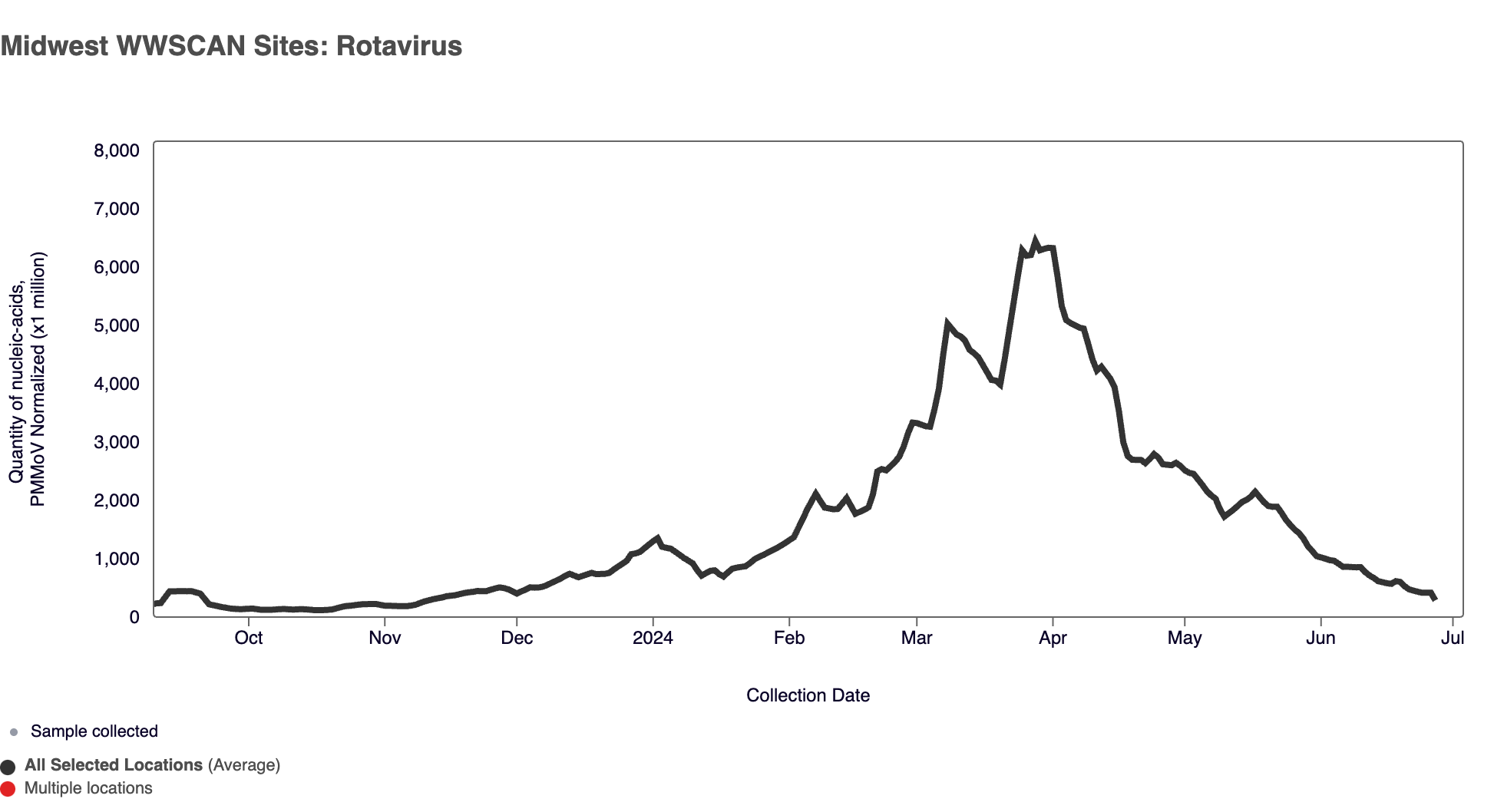
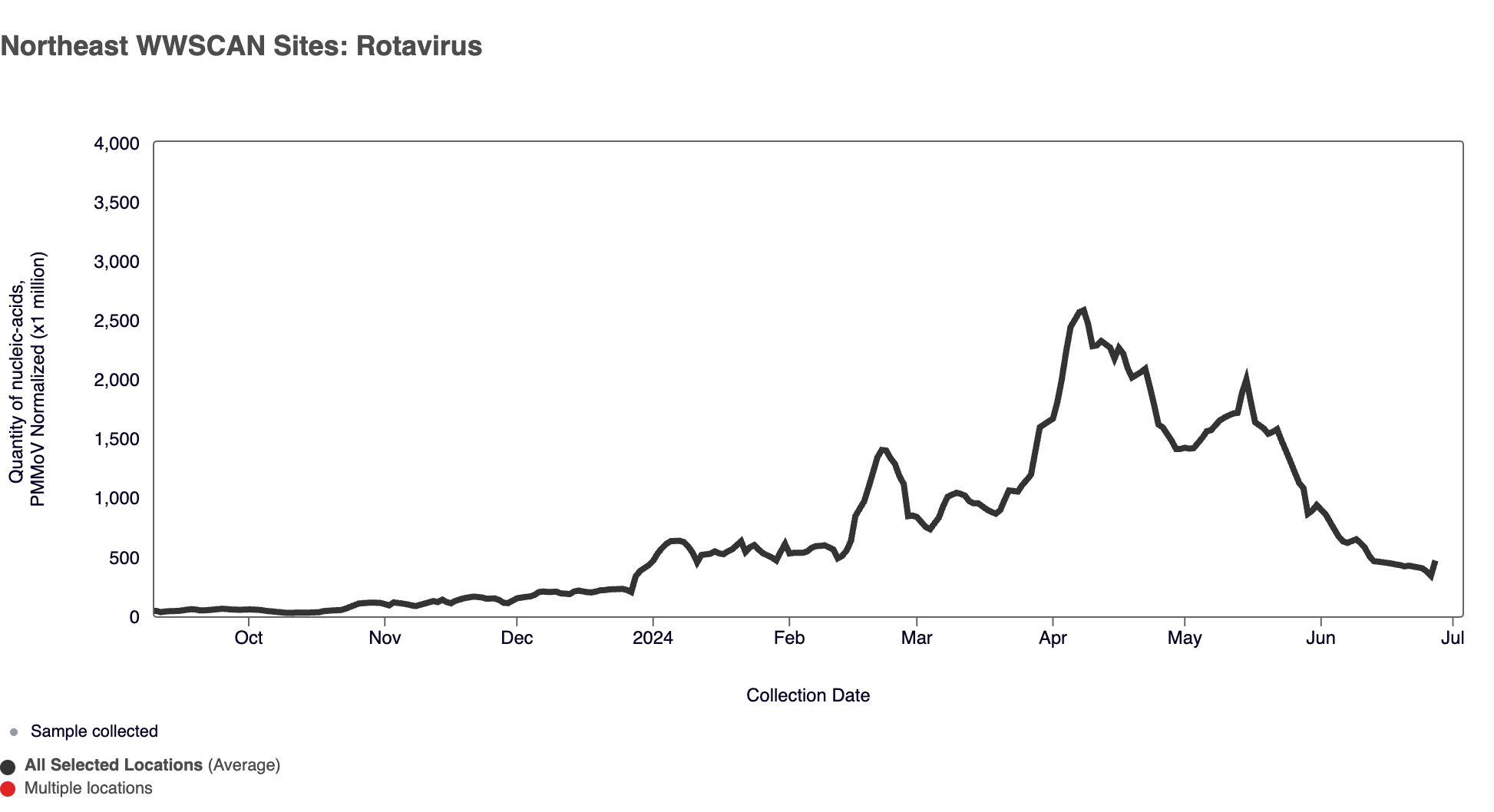
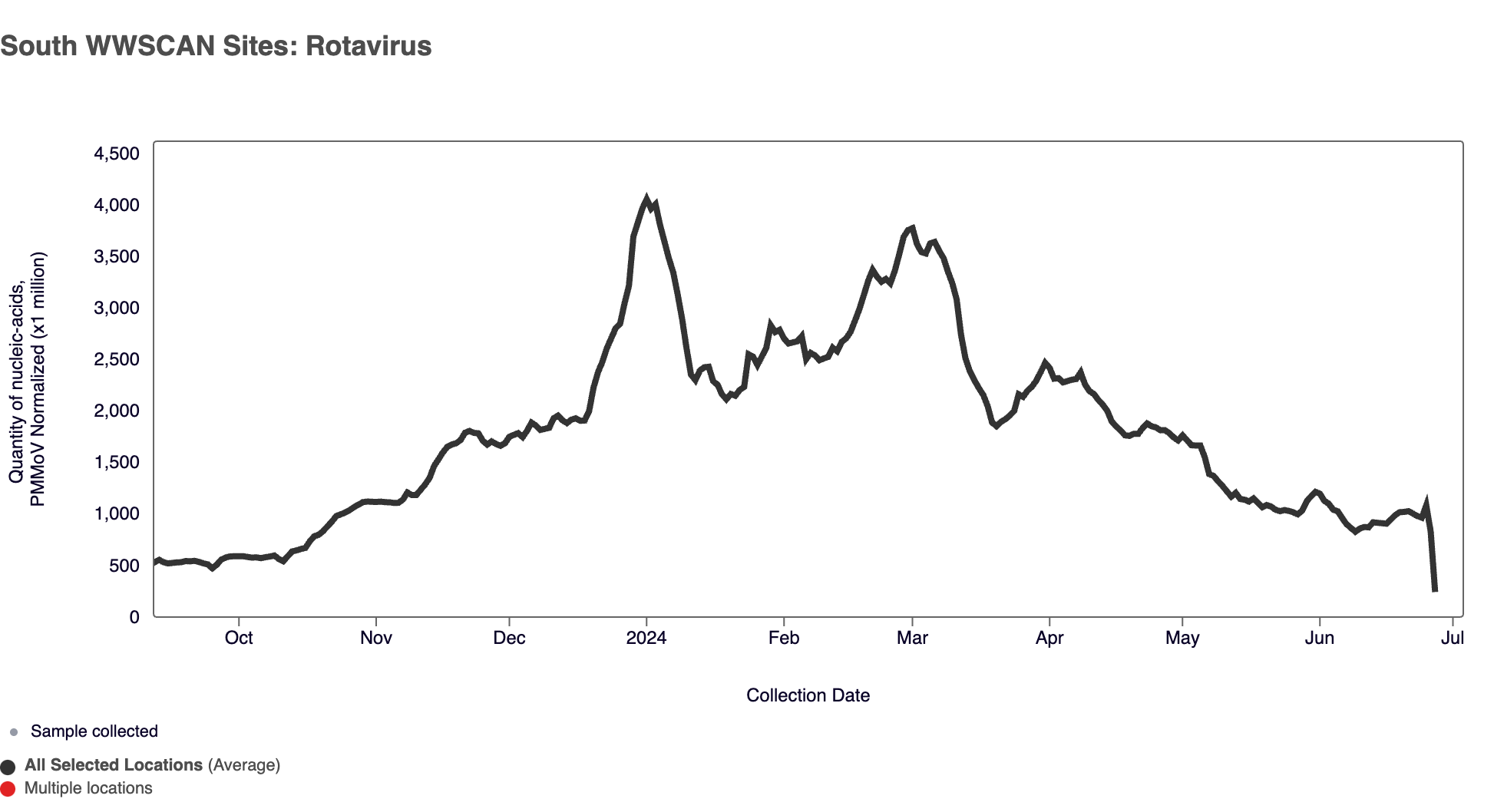
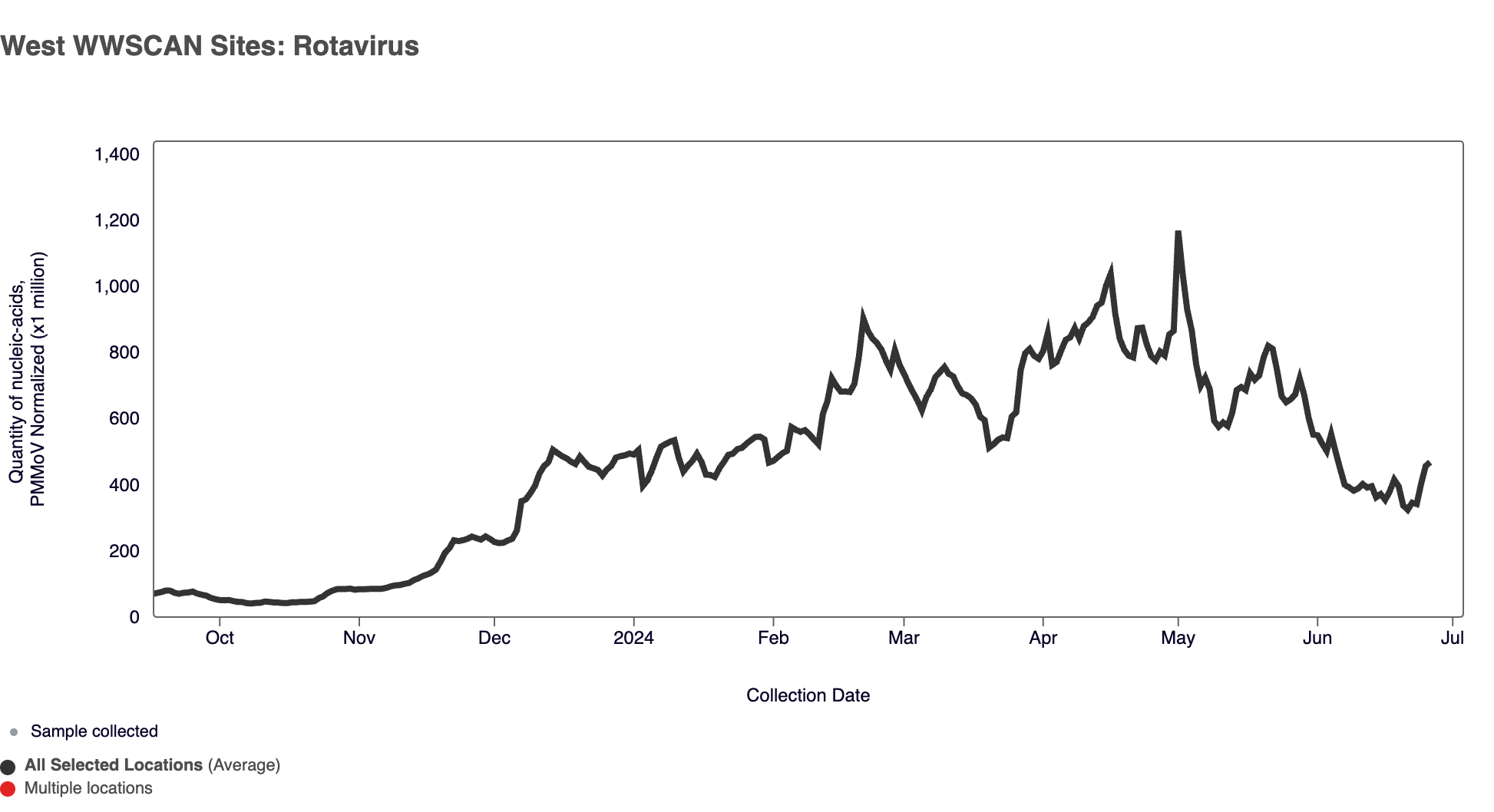
Below are the current Rotavirus wastewater categories for all WWSCAN sites (recall the category is determined by both the trend and the level):
- 74 are in the LOW Wastewater Category
- 72 are in the MEDIUM Wastewater Category
- 25 are in the HIGH Wastewater Category
- 20 do not have enough data to calculate (Contra Costa County, CA; Mill Valley, CA; Newark, CA; Pacifica, CA; Petaluma, CA; San Rafael, CA; South San Diego, CA; Union City, CA; West Railroad, San Rafael, CA; Winters, CA; Blue Plains, Washington, DC; Key Biscayne, FL; South Miami, FL; Columbus, GA; Hilo, HI; York, ME; Gautier, MS; Memphis, TN; Hollywood Road, Amarillo, TX; River Road, Amarillo, TX)

Rotavirus Wastewater Categories. This map includes sample collection data through June 30, 2024. Each dot represents a single site and the four US Census regions are outlined in gray. Midwest states: IA, IL, IN, KS, MI, MN, NE, OH, SD, WI. Northeast states: CT, MA, ME, NH, NJ, NY, PA, VT. Southern states: AL, AR, DE, FL, GA, KY, LA, MD, MS, NC, TN, TX, VA, WV and Washington DC. Western States: AK, CA, CO, HI, ID, NV, UT, WA.
Other Pathogens of Concern
Mpox, Candida auris, and Hepatitis A
Mpox DNA - We have only detected mpox DNA in 2 out of 2,168 samples in the month of June 2024. Nationally, Mpox is in the "Low" category due to limited detections.
The chart below plants in HHS region 5 as rows, and and days as columns (labeled at the bottom axis). White indicates no samples, blue is non-detect for mpox DNA and red is detect for mpox DNA.

Below are the Mpox wastewater categories for all WastewaterSCAN sites (recall the category is determined by the frequency of detection):
- 171 are in the LOW Wastewater Category
- 0 are in the MEDIUM Wastewater Category
- 0 are in the HIGH Wastewater Category
- 20 do not have enough data to calculate (Contra Costa County, CA; Mill Valley, CA; Newark, CA; Pacifica, CA; Petaluma, CA; San Rafael, CA; South San Diego, CA; Union City, CA; West Railroad, San Rafael, CA; Winters, CA; Blue Plains, Washington, DC; Key Biscayne, FL; South Miami, FL; Columbus, GA; Hilo, HI; York, ME; Gautier, MS; Memphis, TN; Hollywood Road, Amarillo, TX; River Road, Amarillo, TX)
Candida auris (C.auris) DNA - We have detected C. auris DNA in 4% of samples from all WWSCAN sites in June 2024. Nationally, C. auris is in the "Low" category due to limited detections.
The chart below shows each WWSCAN plant in New Jersey as rows, and days as columns (labeled at the bottom axis). White indicates no samples, blue is non-detect for C. auris DNA and red is detect for C. auris DNA.

Below are the C. auris wastewater categories for all WastewaterSCAN sites (recall the category is determined by the frequency of detection):
- 167 are in the LOW Wastewater Category
- 4 are in the MEDIUM Wastewater Category
- 0 are in the HIGH Wastewater Category
- 20 do not have enough data to calculate (Contra Costa County, CA; Mill Valley, CA; Newark, CA; Pacifica, CA; Petaluma, CA; San Rafael, CA; South San Diego, CA; Union City, CA; West Railroad, San Rafael, CA; Winters, CA; Blue Plains, Washington, DC; Key Biscayne, FL; South Miami, FL; Columbus, GA; Hilo, HI; York, ME; Gautier, MS; Memphis, TN; Hollywood Road, Amarillo, TX; River Road, Amarillo, TX)
Hepatitis A (Hep A) RNA - We have detected Hep A RNA in 10.1% of samples from all WWSCAN sites in June 2024. Nationally, HepA is in "Low" category due to limited detections.
The chart below shows each WWSCAN plant in HHS Region 3 as rows, and days as columns (labeled at the bottom axis). White indicates no samples, blue is a non-detect for Hep A RNA and red is a detection for Hep A RNA.

Below are the current HepA wastewater categories for all WWSCAN sites (the category is determined by the frequency of detection):
- 160 are in the LOW Wastewater Category
- 11 are in the MEDIUM Wastewater Category
- 0 are in the HIGH Wastewater Category
- 20 do not have enough data to calculate (Contra Costa County, CA; Mill Valley, CA; Newark, CA; Pacifica, CA; Petaluma, CA; San Rafael, CA; South San Diego, CA; Union City, CA; West Railroad, San Rafael, CA; Winters, CA; Blue Plains, Washington, DC; Key Biscayne, FL; South Miami, FL; Columbus, GA; Hilo, HI; York, ME; Gautier, MS; Memphis, TN; Hollywood Road, Amarillo, TX; River Road, Amarillo, TX)
WWSCAN protocols and methods
Protocols (Pre-analytical methods and SARS-CoV-2 analytical methods including controls):
- High Throughput RNA Extraction and PCR Inhibitor Removal of Settled Solids for Wastewater Surveillance of SARS-CoV-2 RNA
- High Throughput pre-analytical processing of wastewater settled solids for SARS-CoV-2 RNA analyses
- Quantification of SARS-CoV-2 variant mutations (HV69-70, E484K/N501Y, del156-157/R158G, del143-145, LPPA24S, S:477-505, and ORF1a Del 141-143) in settled solids using digital RT-PCR
- High Throughput SARS-COV-2, PMMoV, and BCoV quantification in settled solids using digital RT-PCR
Pre-prints and peer-reviewed publications provided WWSCAN methods:
- SARS-CoV-2
- Influenza, Human metapneumovirus, Respiratory syncytial virus, Human parainfluenza
- Mpox
- Norovirus GII
- Adenovirus group F, Rotavirus, Candida auris, Hepatitis A
- Enterovirus D68
Join us at the next WWSCAN Stakeholder call on July 12th, 2024
If you have questions about the website or anything else, please email: wwscan_stanford_emory@lists.stanford.edu
